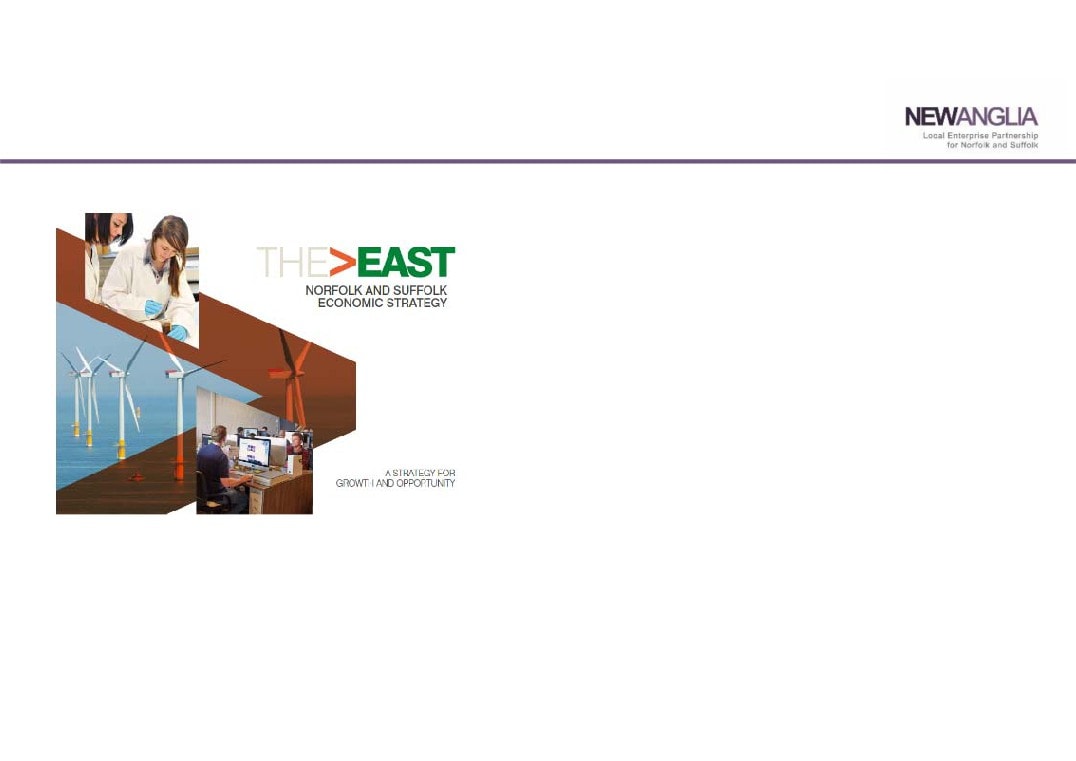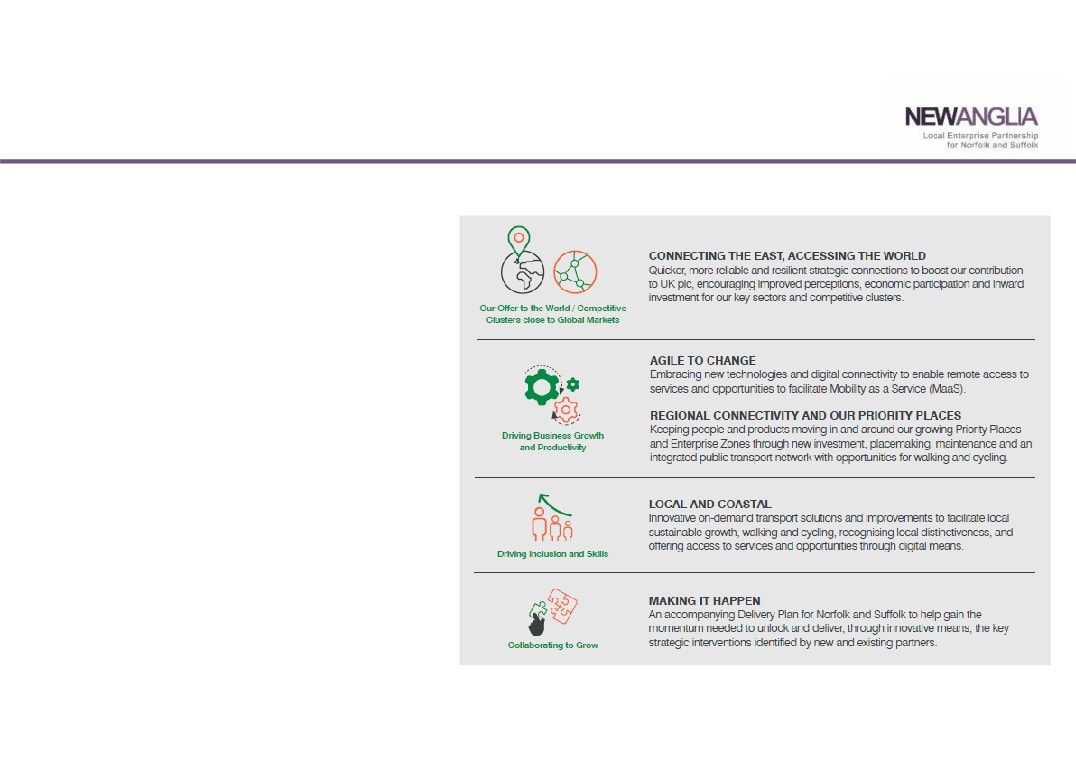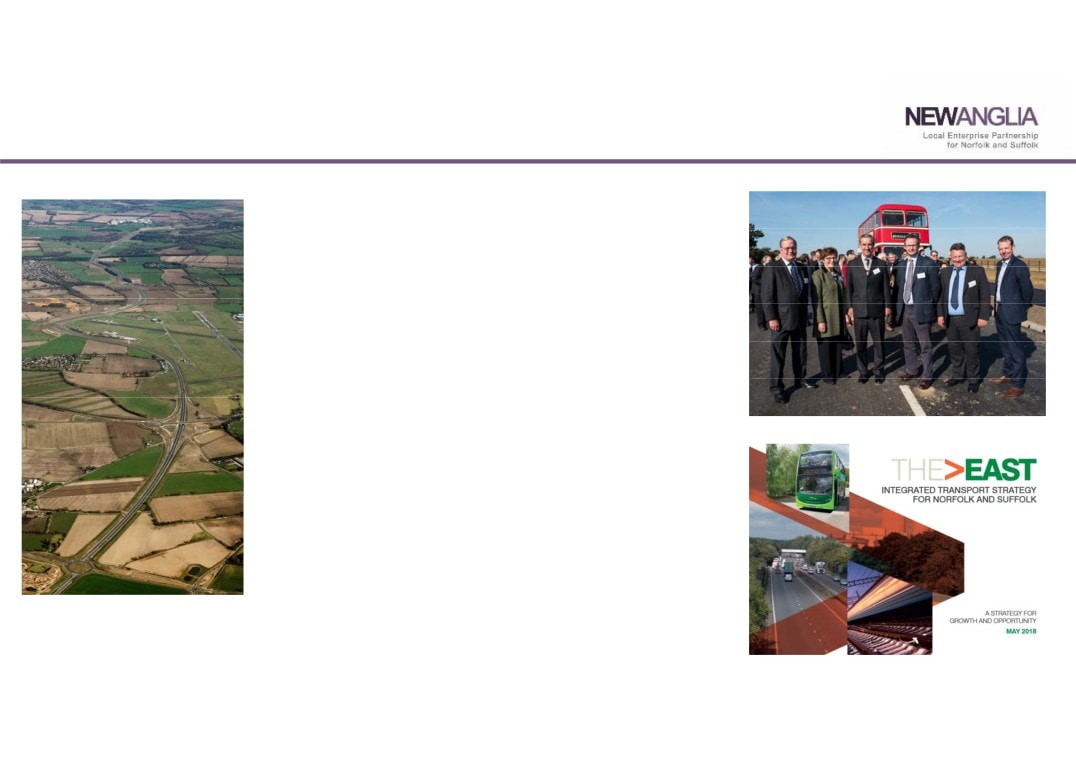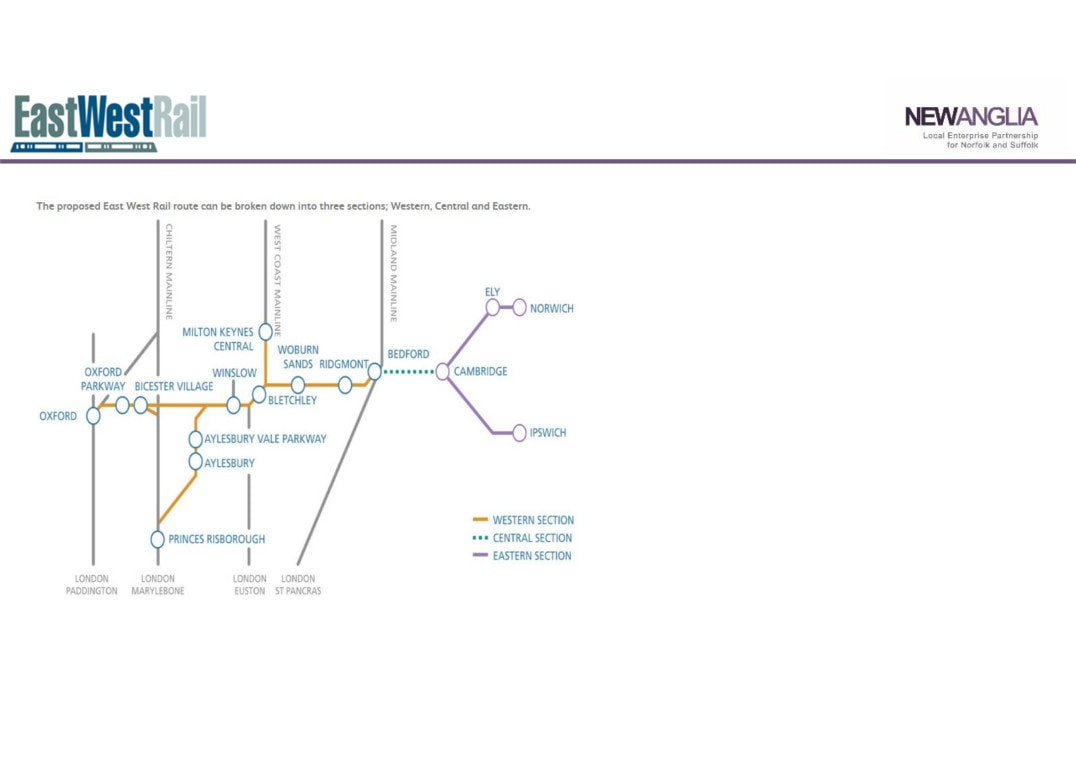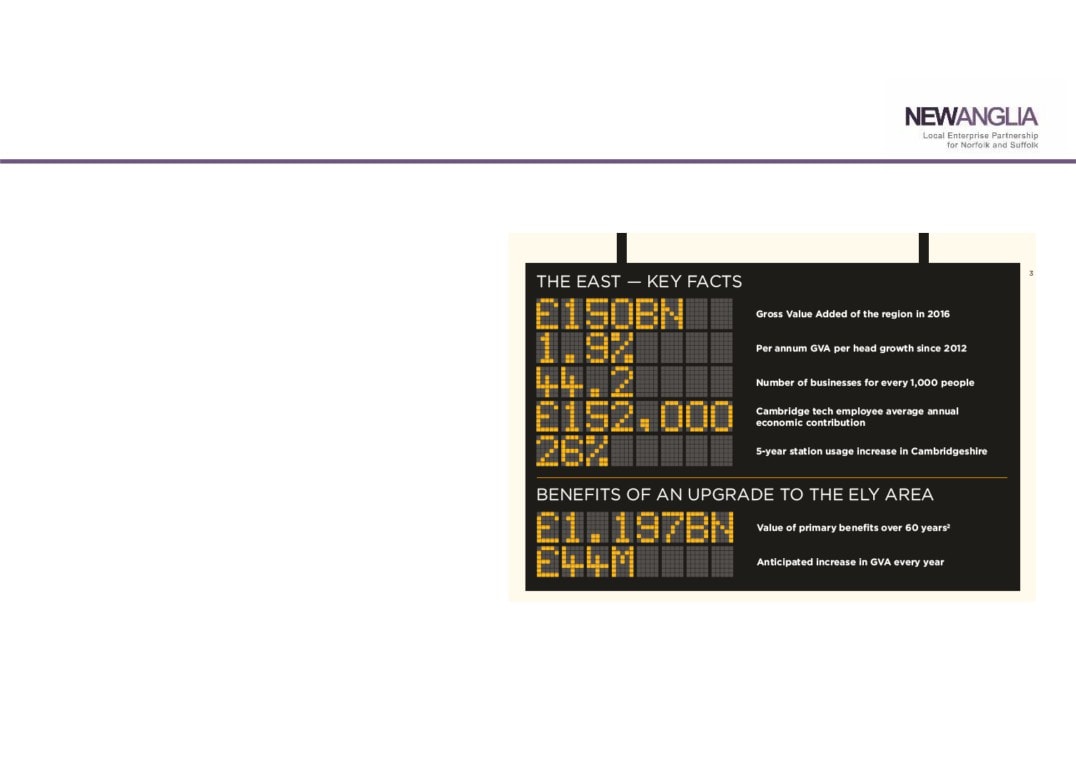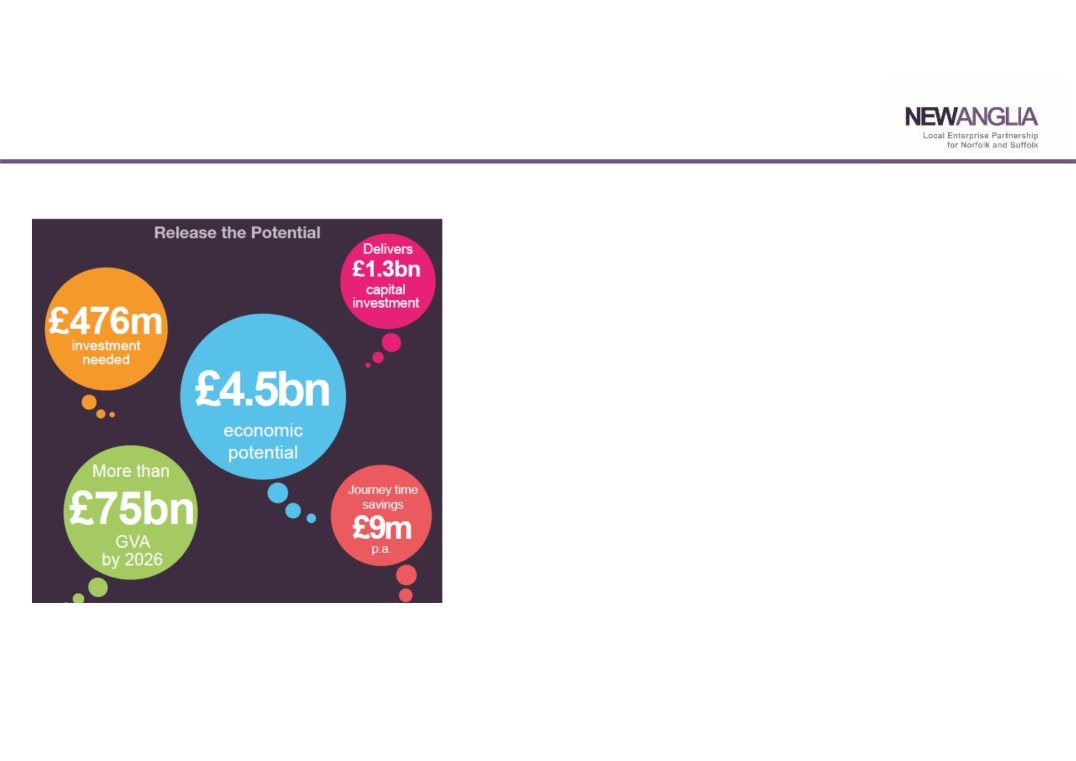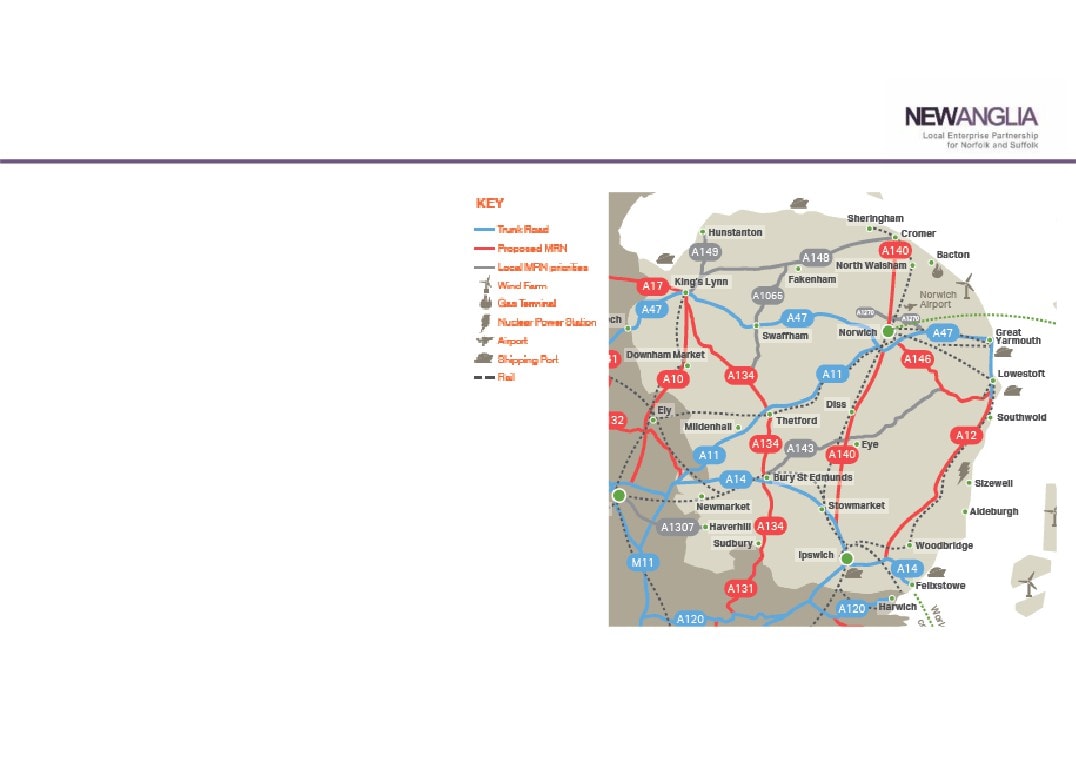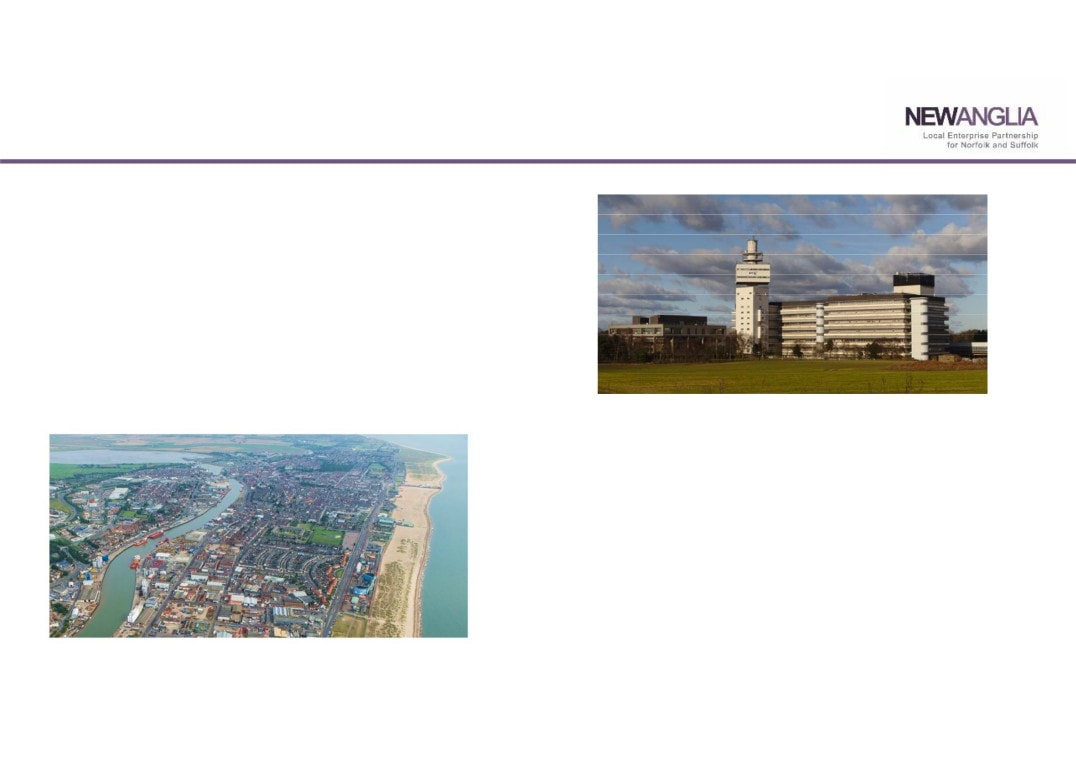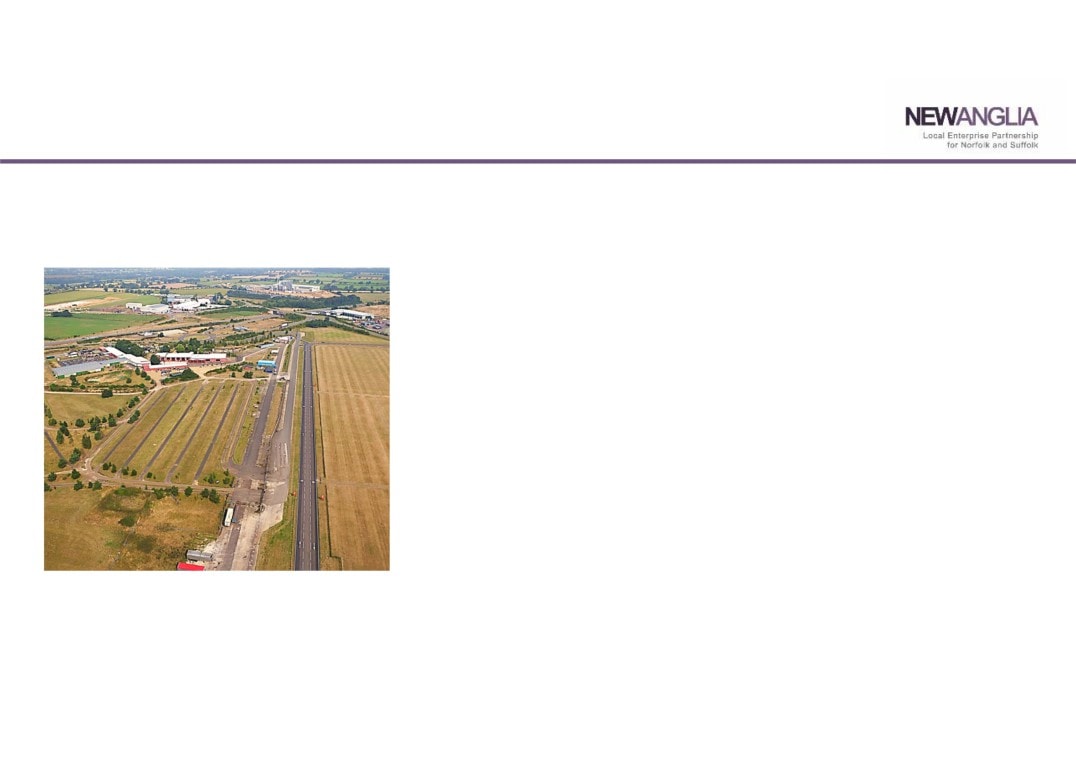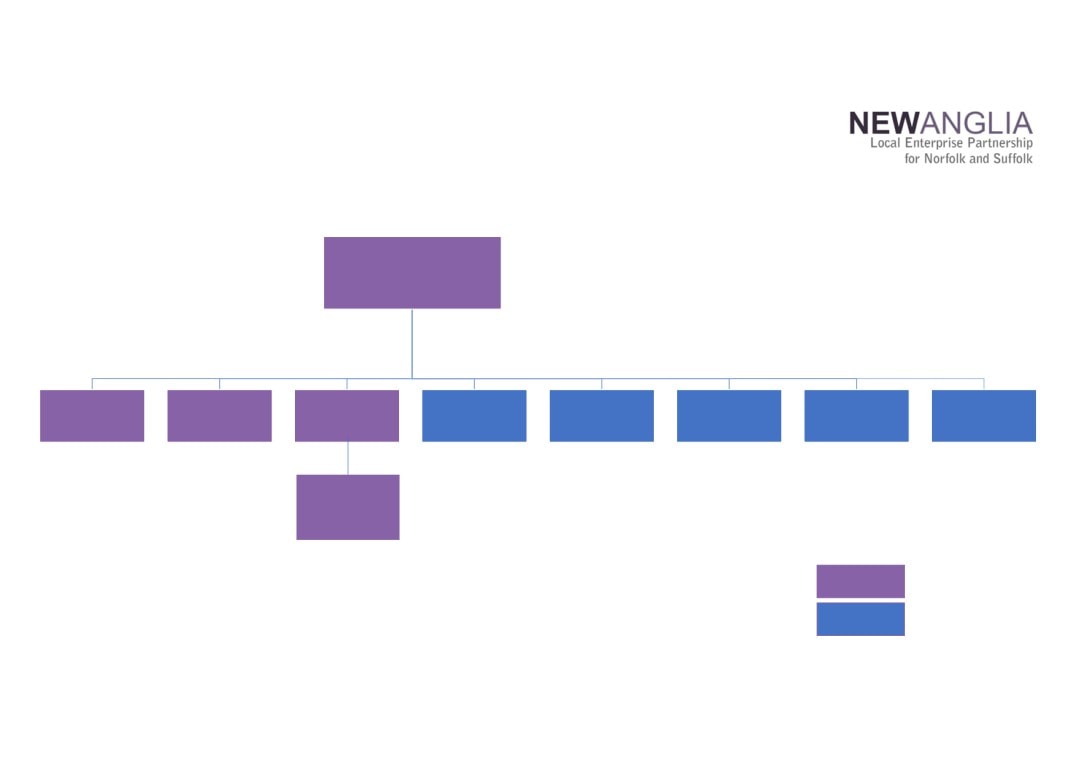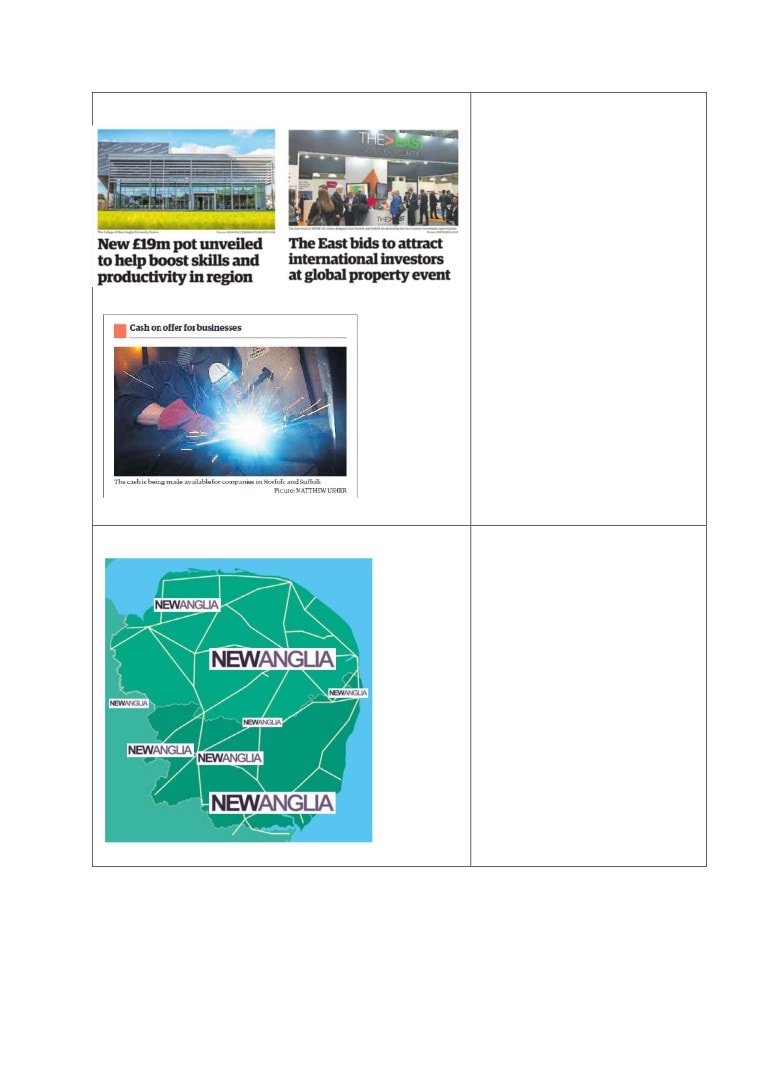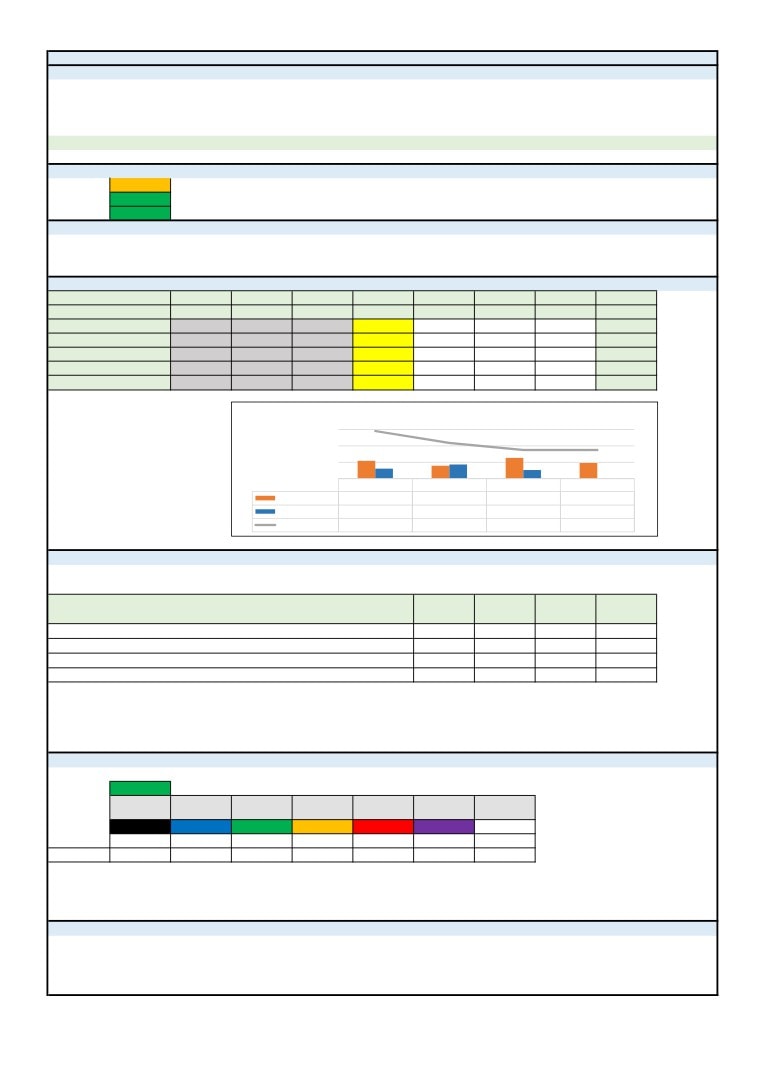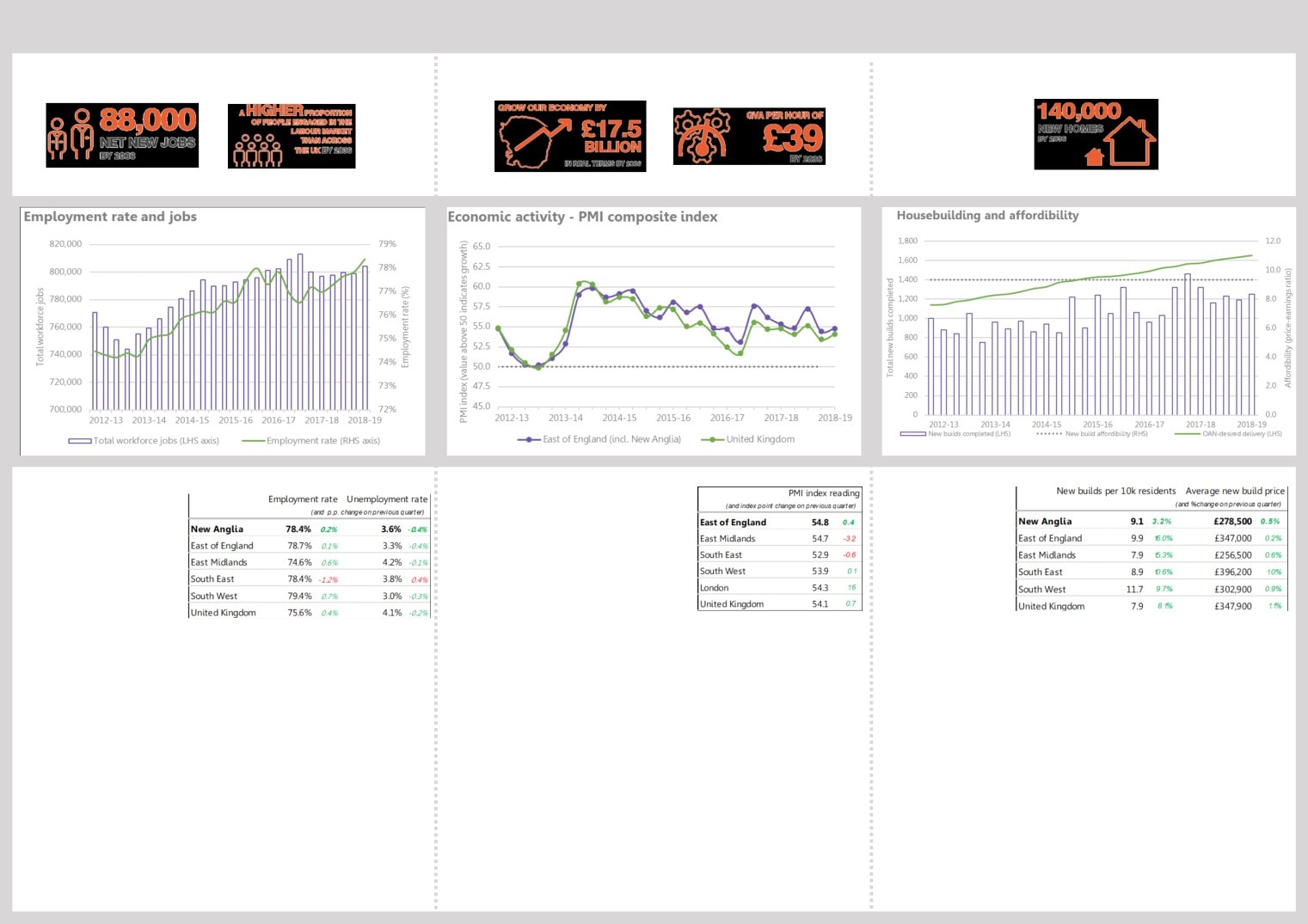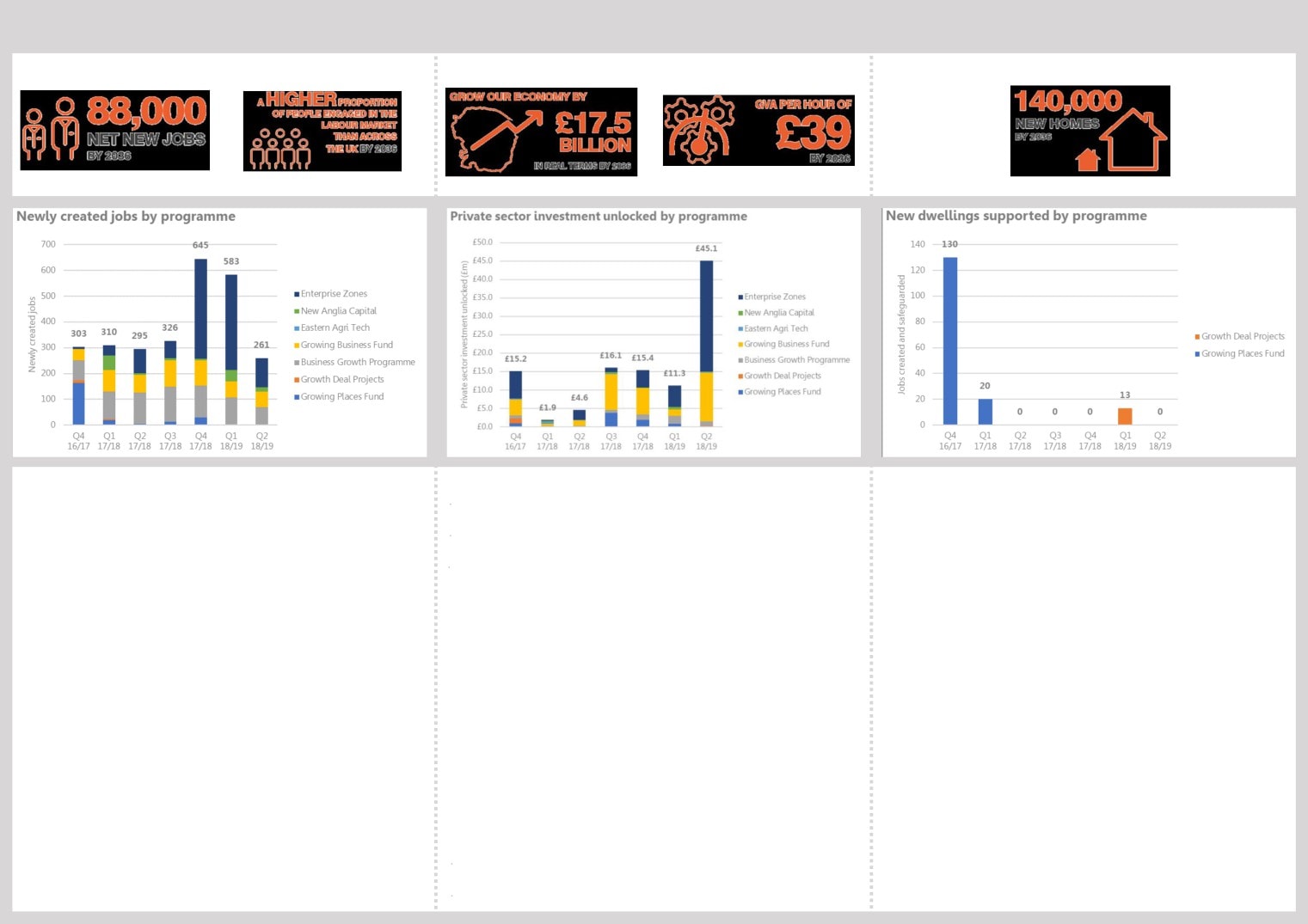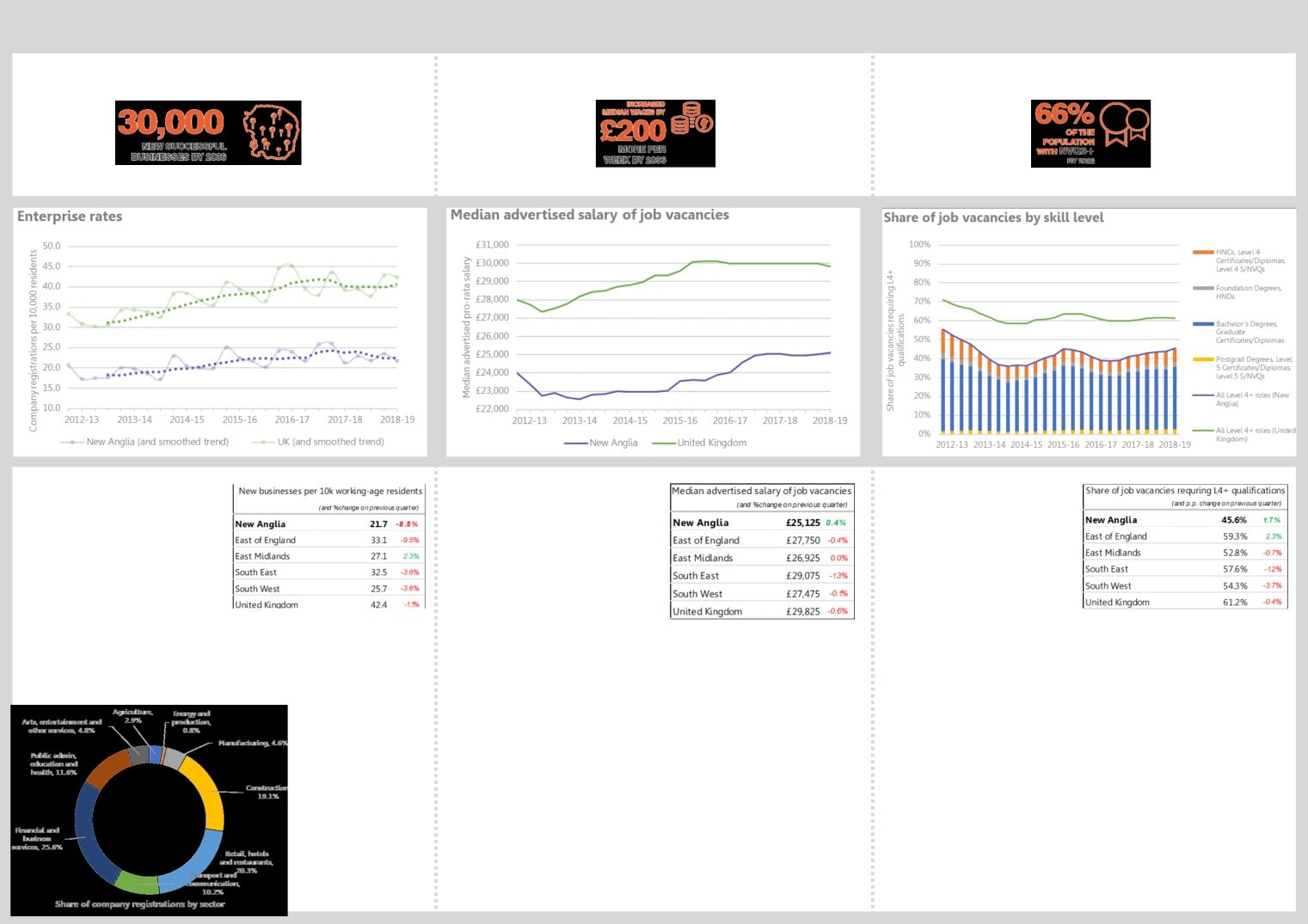New Anglia Local Enterprise Partnership Board Meeting
Wednesday 21st November 2018
10.00am to 12.30pm
Keystone Innovation Centre, Thetford, Norfolk
Agenda
No.
Item
Duration
1.
Welcome
25 mins
2.
Apologies
3.
Declarations of Interest
4
Actions / Minutes from the last meeting
Forward Looking
20 mins
5.
Infrastructure
Update
Governance and Delivery
25 mins
6.
Tier 2 Review
For Approval
7.
LEP Board Governance
For Approval
Break
10 mins
Governance and Delivery
50 mins
8.
Enterprise Zone Accelerator Project - Confidential
For Approval
9.
Brexit
Update
10.
Chief Executive’s Report
Update
11.
November Performance Reports
Update
12.
Finance Report including Confidential Appendices
Update
13.
Board Forward Plan
Update
14.
Any Other Business
Next Meeting: 10.00am - 12.30pm, 30th January2019
Venue:
The Innovation Centre, University of Suffolk, Ipswich
1
New Anglia Board Meeting Minutes (Unconfirmed)
18th October 2018
Present:
Doug Field (DF)
East of England Coop
Dominic Keen (DK)
High Growth Robotics
Johnathan Reynolds (JR)
Nautilus
David Richardson (DR)
University of East Anglia
Lindsey Rix (LR)
Aviva
Sandy Ruddock (SR)
Scarlett & Mustard
Nikos Savvas (NS)
West Suffolk College
Jeanette Wheeler (JW)
Birketts
In Attendance:
Martin Wilby (MW)
Norfolk County Council (For Andrew Proctor)
Mark Bee (MB)
East Suffolk Coastal & Waveney Council (For John Griffiths)
Kevin Maguire (KM)
Norwich City Council (For Alan Waters)
Tom McGarry (TM)
EDF Energy - For Item 3
Jacqueline Bircham (JM)
Norwich Opportunity Area - For Item 6
Vince Muspratt (VM)
Norfolk County Council
Shan Lloyd (SL)
BEIS
Chris Dashper (CD)
New Anglia LEP (For Items 9 & 10)
Chris Starkie (CS)
New Anglia LEP
Rosanne Wijnberg (RW)
New Anglia LEP
Helen Wilton (HW)
New Anglia LEP
1
3
Actions from the meeting: (18.10.18)
Brexit
To receive details of the impact of Brexit on current LEP Projects
CD
Capital Growth Programme Call
To build a process into the call to ensure that all applicants receive a timely response
CD
LEP Review
To receive clarification re the term of appointment for education members following the
CS
reclassification
1
Welcome from the Chair
Doug Field (DF) welcomed everyone to the meeting including Martin Wilby, Mark Bee and Kevin
Maguire who were deputising for Andrew Proctor, John Griffiths and Alan Waters respectively.
DF thanked Tom McGarry for hosting the Board meeting at Sizewell.
2
Apologies
Apologies were received from: David Ellesmere, John Griffiths, Matthew Hicks, Steve Oliver,
Andrew Proctor, William Nunn, Alan Waters and Tim Whitley.
3
Welcome to Sizewell
Tom McGarry (TM) provided the meeting with an update on the Sizewell C project advising
that the next phase of consultation was due to start in January 2019 with the planning
application to be submitted in 2020 and construction due to start 2021.
The presentation covered the plan to replicate large amounts of Hinkley Power Station when
building Sizewell C in order to reduce costs.
TM discussed the skills requirements for the project and the ongoing work to meet shortfalls.
TM stressed the benefits of Sizewell C and requested support from the Board in promoting
the project.
The Board agreed:
To note the content of the presentation
4
Declarations of Interest
Item 9 - Capital Growth Programme Call: Nikos Savvas and David Richardson.
5
Minutes of the last meeting 19th September 2018
The minutes were accepted as a true record of the meeting held on 19th September 2018.
6
Opportunity Areas
Jackie Bircham (JB) presented the Board with an overview of the Norwich and Ipswich
Opportunity Areas (OAs) which had been identified as areas facing challenges to social
mobility based on the Social Mobility Commission’s Index. The Board was advised that the
OA projects will run for 3 years after which findings will be implemented as appropriate to
other areas of the country.
JB reviewed the priority areas identified in both Ipswich and Norwich and the Board watched
a video on the work carried out in the Norwich Opportunity area.
JB stressed that the work to date had showed that there was no lack of aspiration in young
children in these areas but they needed to be shown the route to achieve them.
Jeanette Wheeler (JW) asked about the impact of the lack of SENCO support given the
numbers of pupils identified as needing further help with their learning.
JB advised that the Inclusion Charter considered this issue and noted that schools had been
asked to come up with proposals regarding what would make a difference to pupils which
could include addressing this problem.
Kevin Maguire (KM) asked about the impact of the proposed closures of the Childrens
Centres should they proceed.
JB agreed that this would be an issue as the original plan had been to contact the relevant
families via the Childrens Centres. The project is now having to consider other ways to
2
4
reach out to the relevant children and families wherever they are rather than focussing on
the centres. This could include supermarkets and other community venues.
As a member of the Ipswich OA Board Nikos Savvas (NS) updated the meeting on the
challenges the OAs faced with the limited funding available to them.
Sandy Ruddock (SR) noted the importance of good diet and regular exercise on the ability
to learn and suggested that the latter issue could be implemented with minimal cost.
JB agreed but noted the challenges schools face in delivering the main curriculum meant
that they often focussed on this even though exercise could help their educational
achievements. JB noted that research was being carried out and when the evidence was
produced on the results of programmes such as the Daily Mile it may be incorporated in the
future.
NS stressed that the OAs had no power to change the curriculum or force schools to adopt
any of the measures suggested.
JB asked to Board to support businesses going into schools and also in offering work
experience and also raise the profile of Norwich and Ipswich as OAs.
The Board agreed:
To note the content of the presentation
To support the OAs by raising their profile with businesses
7
Brexit
Chris Starkie (CS) presented the meeting with a paper covering the LEP’s work to date on
Brexit as requested at the last Board meeting.
The Board was advised that there were four main workstreams:
Intelligence - The LEP will continue to act as an information resource to government based
on engagement with business, business intermediaries and local authorities.
Advice - A plan is being developed to provide succinct information on areas of concern to
businesses including the impact of the future UK-EU relationship on companies.
Funding - The LEP is working both regionally and nationally to help shape the future of
funding and has been making the case to Defra regarding transitional funding.
Strategic Opportunities - The LEP is delivering on the ambitions set out in the Economic
Strategy and many actions will be impacted by Brexit either as opportunities or challenges.
Dominic Keen (DK) asked what the LEP could do to help business if market conditions
deteriorated significantly.
CS advised that the workstreams he cited were interlinked and funding would be used to
increase capacity for support as required in order to support companies across the LEP
area.
Lindsey Rix (LR) asked if Board members were receiving questions about Brexit from
businesses. JW felt that businesses were still largely ignorant on the support available for
them now and this would need to be addressed by promoting the help which the LEP could
provide.
LR asked if an analysis of the LEPs current projects had been carried out. CS confirmed
that this would be completed.
Mark Bee (MB) noted that even small changes would have a significant impact of
businesses and it would be beneficial to have the information on these impacts collated in
one place.
David Richardson (DR) suggested that it would be useful to understand the benefits
available from early trade agreements.
JW asked if work was being done to understand the increased costs of doing trade, the
impacts of these on businesses and whether the Board can do anything to address these.
Johnathan Reynolds (JR) noted the importance of understanding impact on specific sectors
and whether any challenges can be exploited as game-changing opportunities.
The Board agreed:
To support the approach detailed in the paper
To receive details of the impact of Brexit on current LEP Projects
CD
3
5
8
LEP Review
CS presented the paper included in the meeting pack detailing the progress made on
implementing the LEP Review.
LR asked whether the level of female representation was a specific target. Shan Lloyd (SL)
advised that this was an ambition and that Government recognised the challenges given the
number of Board members coming from Local Authorities which was outside the LEP’s
control.
It was agreed to change the wording from “target” to ”ambition”.
The Board was advised that, in order to achieve the requirement of having two thirds of
board members from the private sector, it was proposed to amend the LEP’s articles of
association to class education members as private sector and to then to recruit 2 more
private sector members in order to increase the number of private sector board members to
12.
Martin Wilby (MW) asked if the Board was able to be challenge the requirements laid down
for the split of private and public sector board members. CS advised some councils had
already asked for this to be reconsidered but that Government had reiterated that the
requirement would stand.
KM asked if the 3rd Sector was represented and was advised that these were included as
private sector.
NS stressed that this provided the opportunity to recruit 2 new high quality board members.
JW agreed and noted that this would also give the chance to expand the representation of
sectors on the board.
NS asked if he and DR needed to leave the room for the vote. It was agreed that this was
not a requirement.
DR asked for clarification re term of appointment for education members following the
reclassification.
JR noted that a change to the articles would be needed to allow Education board members
to send substitutes.
The meeting voted on the proposal to amend the LEP’s articles of association to increase
the number of private sector board members to 12.
10 Board members voted in favour of the proposal with 1 Board member voting against.
DF proposed that the Articles be amended to allow the Board Members representing
Education to be allowed to send deputies.
This was agreed by the meeting.
The Board agreed:
To note the content of the report
To maintain its existing approach to the recruitment of its chair.
To appoint a deputy chair by February 28th 2019.
To amend the LEP’s articles of association to class education members as private
sector.
To amend the LEP’s articles of association to increase the number of private sector
board members to 12.
To amend the articles of association to allow education sector board members to
send deputies to board meetings
To amend the wording from “target” to ”ambition” in relation to the recruitment of
female board members
Agree to work towards increasing the female representation amongst private sector
board members.
4
6
Ask the LEP chair to write to education and local authority members to highlight the
gender balance recommendations in the LEP Review and ask for support in helping
the LEP board achieve the targets set by Government.
To receive clarification re the term of appointment for education members following
CS
the reclassification
9
Capital Growth Programme Call
DR & NS left the room.
Chris Dashper (CD) reviewed the paper as included in the pack noting that the call would
focus on projects relating to skills, productivity and innovation.
DF noted the importance of infrastructure in the delivery of economic growth across the
region and stressed the importance of understanding how such projects would be delivered
if there were not prioritised in the call.
DF also asked for the mechanism for replying to applicants to be included.
CD noted that there would be other opportunities for infrastructure projects in future funding.
MW stressed the importance of importance of infrastructure in the delivery of productivity
gains and jobs. CD agreed but noted the call was focussing on delivering direct outputs
rather than these indirect outputs.
CS noted the £34m awarded to Norfolk County Council for infrastructure projects some of
which had been carried over from the previous financial year as it was unspent and there
was still slippage in the current ongoing projects.
The Board agreed:
To approve the launch of a focused call on Skills, Innovation and Productivity, to
allocate the remaining £19m of the Capital Growth Programme
For a process to be built into the call to ensure that all applicants received a timely
CD
response.
NS & DR returned to the room
10
Innovative Projects Call
CD reviewed the paper as included in the pack detailing the background to the call and the
source of the fund as Pot C revenue.
CD advised that this funding will be available again and will increase as occupancy of the
Enterprise Zones increases.
JW stressed her support for the proposal and noted that some projects may not
automatically have the sustained funding in place which was detailed in the paper but would
still benefit from support at this stage.
DK asked if there was a preference for the number and size of projects.
CD advised that there was no specific requirements and the focus would be on the outputs
and contribution to the delivery of the Economic Strategy.
JR asked if the call could be linked to the Innovation Board as projects are presented to the
Board and which cannot be funded.
CD advised that this had been considered but it was felt that the call could not be linked to
only one Board however the views of the Innovation Board could be fed in.
MB asked about the funding for expanding Broadband across Norfolk and Suffolk.
It was agreed that this fell under the capital projects call and that it was important to have
funding available for innovative projects.
NS noted that there were various projects going on to delivery digital connectivity locally and
it would be beneficial to pull these together.
The Board agreed:
5
7
To approve the specification and launch of a call for innovative growth projects to be
supported through EZ Pot C income
To approve the eligibility framework
11
Eastern Agritech Report
Rosanne Wijnberg (RW) updated the Board on the progress made on the Eastern Agritech
initiative and recommended to the Board that New Anglia continues to support the initiative
subject to the conditions laid down in the paper.
DF asked if there was an alternative option available which would maintain the programme if
the Cambridgeshire and Peterborough Combined Authority failed to secure the funding
detailed in the paper.
CD advised that if this occurred the framework allowed for the LEP to pick the initiative up
and deliver it alone.
DF clarified the reporting requirements and RW advised that reporting to the Board would
take place on a quarterly basis.
DR stressed the importance of equal branding for the project as historically the role of New
Anglia in the initiative had not been obvious.
The LEP Board agreed:
To approve the continuation of the programme in partnership with the Cambridge
and Peterborough Combined Authority, providing a financial contribution of £1m
towards the programme in 2018/19 under the terms laid out in the report
12
Chief Executive’s Report
CS presented his report to the Board and asked for questions.
CS provided an update on Banham Poultry and advised that he is meeting the MD on 19th
October to discuss development plans and investment.
DF advised the meeting that Emily Manser was leaving the LEP as Growth Deal Manager.
DF expressed the thanks of the Board for Emily for her hard work in delivering the
programme.
The Board agreed:
To note the content of the report
13
October Programme Performance Reports
RW presented the report included in the meeting pack.
The Board agreed:
To note the content of the reports
14
Finance Report
RW reviewed the finance report and asked for questions from the Board.
DF asked if the further £200k from Government for the implementation of the LEP Review
had been factored in. CS advised that this would be done when confirmation was received.
RW confirmed to the Board that, at the AGM on 19th September, approval had been given
for the Board to appoint the new auditors and confirmed that Price Bailey had been
selected.
The Board agreed:
To note the content of the report
To approve the appointment of Price Bailey as auditors
15
Board Forward Plan
CS reviewed the items to be covered at the November Board meeting and that revisions to
the programme was ongoing
6
8
The Board agreed:
To note the content of the plan
16
Any Other Business
NS updated the Board on the Festival of Learning which is an annual event bringing
educators from around the UK and asked for the support of the Board.
CS advised that as part of the Nuclear Sector Deal £10m is being made available to support
the supply chain. Government has agreed that this should be divided up and a proportion of
this spent regionally and a business case has been submitted to this effect.
Next meeting:
Date and time of next meeting:
10.00am - 12.30pm, 21st November 2018
Venue: Keystone Innovation Centre, Thetford
7
9
Actions from New Anglia LEP Board Meetings
Date
Item
Action
Update
Actioned By
Status
18/10/2018
Brexit
To receive details of the impact of Brexit on current LEP Projects
This has been included in the November Brexit update
CD
Complete
paper.
18/10/2018
Capital Growth Programme
To build a process into the call to ensure that all applicants receive a
The process for manaing applications includes timely
CD
Complete
Call
timely response
responses to all applicants
18/10/2018
LEP Review
To receive clarification re the term of appointment for education
Details included in the paper tabled at the November
CS
Complete
members following the reclassification
Board meeting
19/09/2018
Chief Executive's Report
To provide an update on the delivery timescales of major infrastructure
An update will be provided a the November Board
EG
Complete
projects including East West Rail
meeting
21/02/2018
Economic Indicator
To receive a paper on CO2 reductions for
Work is ongoing in conjunction with the UEA
CS/JR
On-Going
Trajectories and Targets:
consideration of inclusion in the economic strategy targets
21/02/2018
Brexit Analysis
To receive an action plan detailing the next steps, timescales and
This will now be a standing agenda item.
LiR
Complete
measures of success
22/11/2017
Business Performance
To receive a proposal on the Eastern Agi-Tech initiative by email.
The LEP Board approved the proposal to continue
CS
Complete
Reports
delivering the Agritech Programme in partnership with
the Combined Authority, subject to certain criteria being
met. The Agritech Programme Performance reports will
be submitted to the LEP Board as per the agreed
reporting cycle.
10
New Anglia Local Enterprise Partnership
Board Decision Log - Public
Date
Decision
Decision Made
Making Body*
18/10/2018
LEP Board
The Board Made the following decisions:
LEP Review
To maintain its existing approach to the recruitment of its chair.
To appoint a deputy chair by February 28th 2019.
To amend the LEP’s articles of association to class education members as private sector.
To amend the LEP’s articles of association to increase the number of private sector board members to 12.
To amend the articles of association to allow education sector board members to send deputies to board meetings
To work towards increasing the female representation amongst private sector board members
Capital Growth Programme Call
To approve the launch of a focused call on Skills, Innovation and Productivity, to allocate the remaining £19m of the Capital Growth Programme
Innovative Projects Call
To approve the specification and launch of a call for innovative growth projects to be supported through EZ Pot C income
To approve the eligibility framework
Eastern Agritech Report
To approve the continuation of the programme in partnership with the Cambridge and Peterborough Combined Authority, providing a financial
contribution of £1m towards the programme in 2018/19 under the terms laid out in the report
18/10/2018
Investment
The IAC made the following decisions:
Appraisal
Albert Bartlett Growing Business Fund Grant Request - Confidential
Committee
MSF Growing Places Fund bridging loan request - Confidential
Nar Ouse Enterprise Zone Investment - Confidential
19/09/2018
LEP Board
The Board Made the following decisions:
Economic Strategy Delivery Plan
To adopt the concept of developing Game Changers.
That the ESDCB should also coordinate development of the Local Industrial Strategy
Local Industrial Strategy
To agree the approach to developing the Local Industrial Strategy
LEP Review
To agree the LEP submission on geography
Programme Performance Reporting
To approve the reporting cycle with the inclusion of NAC
To approve the reporting template
September Programme Performance Reports
To approve the Growth Deal Quarterly Dashboard
19/09/2018
Investment
The IAC made the following decisions:
Appraisal
Capital Growth Programme Autumn Call
Committee
To recommend to the LEP Board that the recommendations in the paper should be supported and the call launched after the October LEP
board meeting
* New Anglia Local Enterprise Partnership Board, Investment Appraisal Committee, Growing Business Fund Panel, Remuneration Committee, Audit & Risk Committee
Revenue Budget Framework
To recommend to the LEP Board that the recommendations in the revenue paper should be supported and the call launched after the
October LEP board meeting
06/09/2018
Investment
The IAC made the following decisions:
Appraisal
Rouen House Grant Variation - Confidential
Committee
05/09/2018
Growing
The Panel approved the following applications:
Business Fund
• Zedbox UK Limited - Agreed to support
Panel
Approved Grant: £120,000
• Westover Vets Limited - Agreed to support
Approved Grant: £126,000
The Panel ratified the following applications:
• DB Sheetmetals Limited (considered and approved by email in August) - Agreed to support
Approved Grant: £60,000
• TML Precision Engineering Limited - Update report
Approved to continue to support - Revised Grant: £95,294
01/08/2018
Growing
The Panel approved the following applications:
Business Fund
• Mirus Aircraft Seating Limited - Agreed to support
Panel
Approved Grant: £140,000
• Vanilla Electronics Limited - Agreed to support
Approved Grant: £39,994
• TBI Manufacturing Limited - Agreed to support
Approved Grant: £69,500
30/0/72018
LEP Board
By written procedures the Board made following decision:
Financial Statements 31st March 2018
To approve the 2017/2018 accounts as detailed in the following papers:
• draft accounts paper
• audit completion document - Confidential
• draft annual financial statements year ended 31 March 2018- Confidential
05/07/2018
LEP Board
By written procedures the Board made following decision:
Capital Growth Programme Honingham Thorpe Food Enterprise Park
To approve a grant of £1m with the following conditions:
• Confirmation of the signature of the contract between Unilever and Condimentum.
• Planning Permission secured for the Condimentum site on the Food Enterprise Park.
• A suitable State Aid mechanism prepared to cover wash-through, clawback and repayment of the grant, to be incorporated into the legal
agreement.
• All terms and conditions to be agreed by the applicant.
04/07/2018
Growing
The Panel approved the following applications:
Business Fund
• LDH (La Doria) Limited - Agreed to support
Panel
Approved Grant: £500,000
• Glowcroft Limited - Agreed to support
Approved Grant: £38,742
• Pecksniffs Bespoke Fragrances & Cosmetics Limited - Agreed to support
* New Anglia Local Enterprise Partnership Board, Investment Appraisal Committee, Growing Business Fund Panel, Remuneration Committee, Audit & Risk Committee
New Anglia Local Enterprise Partnership Board
Wednesday 21st November
Agenda Item 5
Infrastructure Update
Author: Ellen Goodwin
Summary
The provision of high quality infrastructure to support economic growth is a key element of the
LEP’s Economic Strategy.
The LEP plays a number of roles with partners in planning, securing and delivering this
infrastructure.
Appendix A, which will be presented to the board meeting by the LEP’s infrastructure manager,
outlines the different roles of the LEP and partners in the provision of infrastructure and highlights
the progress being made in key strategic projects.
Recommendation
The Board are asked to note the update.
Background
The September board meeting requested an update on the delivery timescales of major
infrastructure projects across Norfolk and Suffolk and beyond where relevant.
The Economic Strategy states that “Infrastructure improvements underpin all our priority places
and themes” so it is critical for the Board and its partners to continue in their role of providing
leadership, lobbying for improvements and securing as well as agreeing funding.
Appendix A outlines the key strategic infrastructure projects which we believe will help to unlock
growth across Norfolk and Suffolk. It is not an exhaustive list of projects being worked on across
the area and there are many key partners involved in the delivery of this infrastructure. The
presentation will be delivered at the Board meeting.
Link to the Economic Strategy
Boosting our infrastructure is central to delivering all our Economic Strategy ambitions. As such
is it a key underpinning priority throughout the Strategy.
Our key policies associated with infrastructure are:
Build the right kind of housing and commercial space where it is needed
Use new rail investment to further improve connectivity
Prioritise digital and physical infrastructure projects
1
13
Commit to further supporting businesses through a smoother planning system,
At a regional level, continue to work with other areas, in particular Cambridge and
Essex, on major physical and digital infrastructure improvements,
Recommendation
The Board are asked to note the update.
Appendix A - Infrastructure presentation to the board
2
14
Appendix A - Infrastructure Update
15
The LEPs role in unlocking infrastructure
FUNDING
Growth Deal
LOBBYING
Key player engagement
LEADERSHIP
Local Transport Board
16
Delivering Norfolk & Suffolk Economic Strategy
•
Make sure that investment markets have the
information they need to take the decision to invest in
infrastructure.
•
Build the right kind of housing and commercial space
where it is needed and integrate infrastructure to build
the communities and places people want to live.
•
Prioritise digital and physical infrastructure projects to
support businesses to develop and provide the space
that new and existing firms need to grow.
•
Commit to further supporting businesses through a
smoother planning system, linking housing and
infrastructure provision with flexible investment plans,
working with Homes England and the Housing Finance
Institute.
•
At a regional level, continue to work with other areas,
Infrastructure improvements underpin
on major physical and digital infrastructure
improvements, and proactively identify opportunities to
all our priority places and themes
create bigger gains across the East.
17
Infrastructure Specifics
Integrated Transport Strategy:
Strengthening the reliability of high
quality mobile coverage
Completing the provision of high speed
broadband
Utility provision for business and new
communities, including local energy
networks
Flood defences that unlock or protect
housing and commercial development
18
Summary of achievements to date
Capital Growth Programme profile:
Invested £83m in connectivity
Invested £68m in unlocking growth
£280.05m public/private leverage
41,640 new/safeguarded jobs
6,300 new homes
Projects agreed in the October 2017 call:
• Bacton Flood Scheme
• Cefas Research Centre
• Snetterton Electricity Scheme
• A140 Hempnall Roundabout
• Eye Airfield Link Road
• Great Yarmouth Flood Defences
• Snape Maltings Flood Defences
Credit: Mike Page
• Honingham Thorpe Food Enterprise Park
19
East West Rail
•
Much progress made on moving towards delivering
both the western and central sections - £20m
announced in the Autumn Budget for the central
section
•
Local authorities have been members of the East
West Rail Consortium for some time but the LEP
agreed to join in September 2018 to help boost the
case for delivering improvements to the eastern
section
•
An eastern section prospectus is being developed
by a focussed group (led by SCC) which is due to be
submitted to the next Consortium meeting on 11
December. It outlines how the delivery of the
eastern section will promote economic growth,
improve national and international connectivity and
add freight capacity to the network.
•
With the necessary support, the eastern section
improvements could be in place during the early to
mid-2020s.
20
Ely area road and rail improvements
•
Ely Taskforce, led by the Borough Council of King’s
Lynn and West Norfolk.
•
In March 2017 the Board agreed to fund the
advancement of the Ely area improvement scheme
by £3.3m as part of a wider funding package. Since
then significant progress has been made in
developing the scheme and identifying potential
road and rail solutions by May 2019.
•
A recent visit to the Chancellor outlined the
economic benefit of the scheme which will allow for
improved passenger services as well as freight
capacity on the network. The LEP co-funded and led
on the work and design of the document.
•
Haughley junction is now being advanced as part of
the wider Ely programme to ensure wider benefits.
•
If future funding is secured it is possible that early
outputs could be delivered during the early 2020s.
21
Great Eastern Mainline Taskforce
• The Great Eastern Mainline (GEML) Taskforce have previously
identified five key priorities for improving the line between
Norwich and London.
• The GEML Taskforce is currently chaired by the Rt. Hon. Priti Patel
MP and has previously been co-chaired by the LEP. The LEP
provides the secretariat support for the Taskforce and the driving
force behind the work programme.
• Network Rail has commenced work on an updated study for the
GEML. Network Rail’s study will feed into the development of a
wider economic study and a Strategic Outline Business Case
which will be published in Spring 2019. New Anglia LEP is
contributing towards the cost of the work.
• The LEP will also lead a programme of stakeholder engagement in
support of the revised business case early in the New Year
working closely with Network Rail and the train operator.
22
Strategic Road Network
No more A14 delays in Suffolk
The multi-partner ‘No More A14 Delays in Suffolk’ campaign, led by the
Suffolk Chamber of Commerce is working to secure improvements to the
A14. Improvements would increase GVA by £362m, help to deliver 7,000
new jobs and offer an average journey time saving of 13 minutes per trip
per day. Suffolk Growth Programme Board have recently commissioned
an EIA of A14 road and adjacent rail corridor.
The A47 Alliance, led by Norfolk County Council, has already been successful in
securing a number of improvements to the A47 as part of Highways England’s first
Roads Investment Strategy. Two further schemes are currently being promoted.
In the longer term the A47 Alliance is campaigning for full dualling of the A47 through
its #justdualit campaign with the Norfolk Chamber of Commerce.
The campaigns are being promoted as part of Highways England’s Roads Investment Strategy post 2020 for delivery before
2025. An announcement is expected in 2019.
23
New Crossings
New Crossings are being progressed in Great Yarmouth, Ipswich and Lowestoft with each having received funding from
Growth Deal and DfT.
Great Yarmouth: Norfolk County Council expect to award the contract for this project by January 2019 after a competitive
dialogue procurement process. The project remains on track to start main works in October 2020 with completion by the end
of January 2023. Local contributions are currently being pursued to support the delivery of the project.
Ipswich: a recent report by Jacobs highlighted a funding gap of £43.2m. Suffolk County Council are currently in discussions
with a number of relevant bodies about closing the funding gap to enable the Upper Orwell Crossings project to proceed.
Lowestoft: the planning application for the new crossing has recently been accepted. The start of the public examination is
expected to begin on 5 December with a decision expected in 2019. Construction is programmed to begin in 2019 or 2020
and is scheduled to complete in 2022. Local contributions are currently being pursued to support the delivery of the project.
24
Major Road Network
• A10 improvements
• A12 Suffolk Energy GateWay (SEGWay)
• A1307 improvements
• Ipswich Northern Route/s
• Long Stratton Bypass
• Norwich Western Link
• Sudbury junction improvements
• West Winch Housing Access Road
With the support of Transport East, Norfolk County Council has
submitted a Strategic Outline Business Case to DfT for the early
release of MRN funding to deliver the A140 Long Stratton bypass.
Transport East has also written to government to make DfT aware
of projects that are likely to be priorities for future funding in the
short term. The schemes put forward in Norfolk and Suffolk are the
Sudbury congestion relief scheme and the A10 West Winch
Housing Access Road.
25
Innovation in transport
To respond to the future challenges we must
remain AGILE TO CHANGE
The Mobility as a Service
•
Open to innovative new technologies
(MaaS) model puts the
•
Connectivity - not just physical - reducing the
customer first and frames
need to travel
the mobility systems
•
Use data to enable the more intelligent operation
around customer
of our networks
preferences. MaaS offers
•
Electric/hydrogen vehicles and associated air
an opportunity to
quality improvements
improve how people and
•
Connected and Autonomous Vehicles
goods move, both from
•
Behaviour change
the perspective of the
•
Local Transport Board working with Transport
policy maker and for
Systems Catapult
travellers themselves.
•
Transforming Cities Fund - Norwich second phase
•
£90m for Future Mobility Zones
26
Utilities
Utility provision for business and new communities, including
local energy networks
Strong local authority leadership to date
Norfolk and Suffolk Energy Coast (including Sizewell and
offshore wind opportunities) a Priority Place in the Norfolk and
Suffolk Economic Strategy
Co-partner on the Local Energy East Strategy with the Combined
Authority and the Hertfordshire LEP/Energy Hub Board member
Funded and led the work package for the recent Building
Growth Group Utilities Workshop focussed on resourcing,
regulation, relationships and funding.
£2.65m to expand existing electricity supply capability and
support substantial industrial business growth at Snetterton
Heath by building a new substation and installing new cabling to
improve electricity supply to the site.
27
Digital and Flooding
Strengthening the reliability of high quality mobile coverage
Completing the provision of high speed broadband
Strong local authority leadership - Better Broadband programme
Through our Growth Deal, we have invested £10 million in
projects in both counties to support an increase in the extensive
network of fibre cables and roadside cabinets to enable homes
and businesses to have access to faster broadband.
Flood defences that unlock or protect housing and commercial
development
Local Lead Flood Authorities and Coastal Partnership East
£10m in Lowestoft
£8.2m in Great Yarmouth - and innovative funding solutions
£6.6m in Ipswich Growing Places loan
£1.08m Bacton to Walcott
28
2019
OBC for Ely area
2023
RIS2 decision
Great Yarmouth crossing
2021
GEML SOBC finalised
open
Growth Deal projects
RIS1: GY junctions begun
complete
New train rollout - Norwich
RIS1: Blofield to Burlingham
in 90/Ipswich in 60 4x a day
and North Tuddenham to
Easton dualling begun
Mid 2020s
East West Rail delivered*
2020
Ely road and rail
Energy Hub financially
improvements delivered*
sustainable
RIS2 projects delivered*
98% superfast broadband
East Anglia franchise
coverage in Suffolk, more
2022
renewed
than 95% in Norfolk
Lake Lothing crossing open
*subject to preferred options and funding
RIS1: Thickthorn junction
decisions
begun
29
Key Next Steps
Funding
• Delivery of Growth Deal projects by 2021
• Secure a strong funding allocation from the UK’s Shared Prosperity Fund
Lobbying
• Ultra fast broadband, full-fibre solutions and better mobile connectivity
for the whole of Norfolk and Suffolk
• Greater South East Energy Hub engagement to ensure our ambitions are
well understood at the strategic level
• Advance the Ipswich Northern Route/s and Norwich Western Link projects
• Commitment to Ely area and Haughley junction improvements
• RIS2 funding announcements for A14 and A47
• GEML and East-West Rail lobbying to ensure our message is heard
Leadership
• Local Transport Board governance review
• Innovative utility solutions
• Innovation in flood defence funding
• Local Energy East Delivery
30
New Anglia Local Enterprise Partnership Board
Wednesday 21st November 2018
Agenda Item 6
Tier 2 Governance Review
Author and presenter: Chris Starkie
Summary
This paper makes a number of recommendations as part of the review of Tier Two Governance
instigated by the PwC review into the LEP’s governance and operations.
It aims to bring into line the governance of advisory boards covering transport, skills, innovation,
inward investment and sectors.
This builds on the work done to improve the Governance of the main LEP board and its boards
responsible for finance and corporate governance.
A diagram of the boards covered by tier one and tier two reviews can be seen at appendix 1.
Recommendations
The LEP board is asked to endorse the continued role of the LEP Skills Board with its
terms of reference amended in the paper.
The LEP board is asked to agree to amalgamate the Local Transport Body and Board
into a single forum with greater emphasis on developing and implementing the
Integrated Transport Strategy Delivery Plan.
The LEP board is asked to agree further work to determine the required composition,
membership and name of the new transport group and produce appropriate Terms of
Reference, ensuring it aligns with other bodies in the second tier Governance review.
The LEP board is asked to endorse the continued role of the LEP Innovation Board and
approve a review into its Terms of Reference, membership and outputs.
The LEP board is asked to support a review of the aims, objectives and terms of
reference of the International and Inward Investment Sub-group.
The LEP board to ask the LEP executive to work with the sector groups to develop
common terms of reference which improve their accountability to the LEP board.
In some cases this will mean developing the existing terms of reference of the groups.
Where the group is part of a membership organisation, this will mean creating a
separate sector group to focus on the leadership and coordination of the sector.
Background
1
31
In autumn 2017 the LEP board agreed a plan to implement the recommendations of a report
into the LEP’s governance and operations.
The PwC report made a series of recommendations aimed at strengthening the organisation
and governance of the LEP to ensure it remains best in class.
Further recommendations around governance were then introduced in winter 2017 as part of
the Government’s review of LEP governance undertaken by Mary Ney.
These additional recommendations were implemented alongside the PwC recommendations
during winter 2017 and the first half of 2018.
A third round of governance changes was then adopted by the LEP board in autumn 2018
following the Government’s Review of LEPs which was published in summer 2018.
Having reviewed the PwC implementation plan and the Ney Review, one remaining element of
the PwC plan still needs to be endorsed by the LEP board - the review of Tier Two
Governance.
For context the Tier One Governance structures were agreed by the LEP board at the end of
2017.
That is the terms of reference and scheme of delegation for the LEP board itself, the Audit and
Risk committee, the Investment Appraisal Committee and the Remuneration Committee.
Terms of reference was also agreed for executive team led sub-groups - the Economic Strategy
Coordinating Delivery Board and the LEP Management Committee.
Tier Two Governance covers other boards and groups which sit beneath the main LEP board.
Key Issues
The specific action in the PwC review around tier two governance was as follows:
Formalise the reporting process from the sub-committees, boards and groups to the Board on
the activities undertaken by those bodies. Such updates can range from a regular formal
update papers with request to scrutinise and approve decisions, to an annual or bi-annual
presentation on activities undertaken by the sector groups.
Our review of these groups places them into three categories:
1 Formal sub-boards or sub-committees of the LEP
2 Sector groups
3 Partnership bodies which are supported by the LEP
This paper proposes how the LEP formalises its arrangements for the first two categories of
group. A further paper at a future date will cover the third category.
1. Formal sub-boards of the LEP
These groups have been established by the LEP and are fully accountable to the LEP for their
actions.
The Tier One review covered sub-boards or sub-committees had either a delegated financial or
governance role.
2
32
These groups have all been established to provide advice and support to the LEP board on
specific parts of the LEP’s overall remit.
The groups are as follows:
1. New Anglia LEP Skills Board
2. New Anglia LEP Local Transport Body
3. New Anglia LEP Local Transport Board
4. New Anglia LEP Innovation Board
1) Skills Board
The LEP Skills Board was established by the main LEP board to provide focused leadership on
the skills agenda.
It enables a wide body of skills experts to come together to provide advice and support to the
LEP board on the employment and skills agenda.
It also provides a forum for skills providers, the private sector and other bodies such as Job
Centre Plus to work together to support the skills agenda.
Activities have included the development of sector skills strategies and the oversight of a
number of European funded skills programmes.
Its terms of reference were revised in March 2018 to fit in with the PwC review and also to
support delivery of the LEP’s Economic Strategy.
Responsibility for funding of skills projects is currently retained by the LEP board and the
Investment Appraisal Committee, with the Skills Board serving as an advisory body.
The terms of reference are attached at Appendix 2.
The LEP board recently agreed that the private sector chair of the Skills Board would provide
two updates a year on progress being made by the board, which will provide a clear conduit of
information to the LEP board.
We believe the Skills Board fulfils a meaningful role and should be retained in its current form.
To bring fully into line with the LEP’s governance the terms of reference will need a minor
revision - with the board members annual declarations of interest being available online.
Recommendation
The LEP board is asked to endorse the continued role of the LEP Skills Board with its terms of
reference amended as above.
2) Local Transport Body and 3) Local Transport Board
Local Transport Body
Generally, the Local Transport Body oversees the delivery of the LEP’s transport schemes, and
the Local Transport Board advises the LEP on transport related needs and priorities.
The Body is a voluntary committee comprising Norfolk and Suffolk County Councils and New
Anglia LEP. It was formed in 2013 in response to a Department for Transport (DfT) initiative to
devolve the control of capital funds for major transport schemes to Local Enterprise Partnership
(LEP) areas, in line with the Government's localism agenda.
Since the Body was established the way transport funding has been allocated and managed
locally has fundamentally changed. In 2015 Government announced that funding for transport
3
33
schemes would be directed through the LEP’s Growth Deal. In response to this, the New Anglia
LEP Board took over responsibility for agreeing funding for the transport projects originally
approved through the Body.
Local Transport Board
The Local Transport Board was set up in 2014 to help shape our local transport system by
bringing together key transport specialists from both local authorities, regional and national
bodies, and transport operators. It was intended to pool their expertise to:
•
Provide strategic direction on transport issues;
•
Understand the partners’ transport ambitions;
•
Ensure the transport network satisfies the needs of business;
•
Allow for the design and shaping of an Integrated Transport Strategy for New Anglia;
•
Assess how New Anglia and partners can best deliver the Integrated Transport
Strategy.
The Local Transport Body’s current role is to:
1. advise to the LEP board which transport investments should be programmed,
2. review and approve individual business cases for those investments, and
3. ensure effective delivery of the programme.
Our recently approved Integrated Transport Strategy is presenting a clearer picture about the
types of transport projects we need to meet the ambitions of our Economic Strategy. Therefore,
selecting which transport projects should be programmed has been made simpler, and to
rationalise our governance it is a role that the Transport Board can undertake.
In January 2018 as part of the implementation of the PwC review, the role of the LEP’s
Investment Appraisal Committee (IAC) was extended to review and approve all LEP investment
decisions. This means that the Local Transport Body no longer needs to perform this function
and presents an opportunity for rationalisation. There are just £375,000 worth of allocated funds
still to be considered within 3 detailed business cases pertaining to separate highway schemes.
These can be considered by the IAC.
The effectiveness of delivery is currently presented to each meeting in a Performance
Management Report (PMR), which includes a Red-Amber-Green (RAG) rating and comments.
This report lacks detail, accuracy and alignment to the wider Growth Deal programme plan.
This can be better achieved through open and frank dialogue between delivery partners and the
LEP Executive, with performance reported up through the LEP Management Committee.
Considering revised local governance arrangements, the majority of LEPs have already
dissolved Local Transport Bodies, with only 9 of 38 LEPs retaining them.
Whilst providing strategic direction on transport issues, the Local Transport Board was tasked
with:
• Acting as a forum for information and expertise sharing, discussion and debate;
• Acting as a powerful advocate for Norfolk and Suffolk on behalf of New Anglia LEP;
• Developing a stakeholder management plan;
• Producing a work programme summarising individual scheme progress;
• Offering recommendations for prioritisation of projects for funding.
In its current form, the Board has provided a useful forum for the sharing of information
regarding all manner of transport related topics, local as well as regional initiatives and projects.
4
34
It has discussed a wide breadth of topics, garnered opinion and advise, and supported specific
actions.
Notwithstanding this, it proved difficult to engage the Board in specific workstreams due to its
large and diverse nature. There are opportunities to make the Board more focussed now that
the Integrated Transport Strategy moves towards the implementation phase.
Additionally, the establishment of a Sub-national Transport Forum, Transport East, is starting to
assume responsibility for considering wider regional transport needs and their advocacy,
through which the needs of Norfolk and Suffolk could also be effectively channelled.
Proposal
We propose the amalgamation of the Local Transport Body and Board into a single forum, the
Transport Implementation Group, with an emphasis on implementing the Norfolk and Suffolk
Integrated Transport Strategy.
This proposal involves the dissolution of the Local Transport Body and incorporation of its
functions into alternative LEP governance structures, as follows:
1
Advise to the LEP board which transport
Transport Implementation
investments should be programmed
Group
2
Review and approve individual business
IAC (<=£500k)
cases for those investments
/ LEP Board (>£500k)
3
Ensure effective delivery of the
Management Committee
programme
Focused on a programme of delivery, the Transport Implementation Group will be able to
advise the LEP Board which transport investments should be supported. This approach can
also better align the approval of transport investments with other projects and would remove
duplication between the Body and both the Investment Appraisal and Management
Committees.
While the purpose and ambitions of the Transport Board largely still stand, and the Integrated
Transport Strategy has been adopted, the relationship between a redefined group and the
wider LEP governance could be improved with revised and output focussed terms of reference.
Activities should include:
•
Develop, maintain and execute the Integrated Transport Strategy Delivery Plan,
reporting to the Economic Strategy Co-ordinating Delivery Board;
•
Meet quarterly for discussion and prioritisation of delivery;
•
Manage the work and tasks of members;
•
Produce and execute a Stakeholder Management Plan;
•
Direct the formation and tasks of working groups to tackle specific topics.
It is therefore proposed the Transport Implementation Group is given the following purpose:
“Ensure current & future transport networks meet the needs of both businesses and
residents in order to support economic development & growth.”
This group would offer advice and prioritise transport initiatives and projects, although all future
investments will be subject to the standard process of appraisal, considered by the IAC first and
then if necessary by the LEP Board.
5
35
The Transport Implementation Group would also contribute a Norfolk and Suffolk perspective
into Transport East.
The Transport Implementation Group or a subset of it could also act as a task and finish group
for the recently adopted Ports and Logistics Sector Skills Plan. This group would report to both
the Transport Implementation Group and the Skills Board.
Membership
Membership of the Transport Implementation Group will need to be reviewed to ensure the
agreed purpose can be met. District and borough Councils have expressed a wish to be
members, so this will need to be considered as part of this process.
It is proposed that the Chair continues to be LEP appointed and from the private sector.
As part of this process it is proposed the secretariat for the group is transferred to the LEP
Executive Team.
Recommendation:
The LEP board is asked to agree to amalgamate the Local Transport Body and Board into a
single forum with greater emphasis on developing and implementing the Integrated Transport
Strategy Delivery Plan.
The LEP board is asked to agree further work to determine the required composition,
membership and name of this group and produce appropriate Terms of Reference, ensuring it
aligns with other bodies in the second tier Governance review.
4) New Anglia LEP Innovation Board
The Innovation Board was set up in 2015 to provide a focus for decision making and leadership
regarding innovation strategy, programme and project development. Since its inception, it has
championed a number of initiatives including the Government Science and Innovation Audits
and building strategic relationships with national organisations such as Innovate UK and the
Smart Specialisation Hub.
Innovation is at the centre of the Government’s Industrial Strategy and a key focus within New
Anglia’s Local Industrial Strategy. Given this increasing focus, we believe that the Innovation
Board fulfils a meaningful role and should be retained. However, structural changes are needed
to enable the Board to fully support the delivery of the Economic Strategy and Local Industrial
Strategy and to provide wider engagement with innovation stakeholders across the region.
A review of the Innovation Board is currently underway and LEP executive are in the process of
meeting with Innovation Board members individually to get their input into the plans.
The next stage will be to present a revised Terms of Reference, Delivery Plan and Forward
Plan for approval at the next Innovation Board meeting in the new year.
Recommendation
The LEP board is asked to endorse the continued role of the LEP Innovation Board and
approve a review into its Terms of Reference, membership and outputs.
6
36
International and Inward Investment Sub-Group
Established in 2017, a small sub group of the LEP board was established to oversee and steer
the international relations, trade, inward investment and place promotion activity of New Anglia
LEP.
In light of emerging opportunities as a result of national sector deals, international trade deals,
the Local Industrial Strategy and the drive for stronger collaboration and promotion to attract
new investment to Norfolk and Suffolk, there is a need to review this group.
An assessment of its aims, objectives and Terms of Reference will be undertaken with
recommendations on enhancing membership and developing a focused strategy and delivery
plan for 2019-20.
Recommendation
The LEP board is asked to support a review of the aims, objectives and terms of reference of
the International and Inward Investment Sub-group.
Sector Groups
The Economic Strategy identifies nine priority sectors and in most cases sector groups have
been the primary point of reference and voice for these sectors. They are not part of the LEP’s
governance structure but provide specialist advice and intelligence to the LEP on behalf of their
sector.
LEP sector groups come together as communities of interest and as such, are expected to be
self-motivated and set their own general objectives within the framework of the Economic
Strategy.
Some groups were established pre-LEP, which means they have their own governance
structures and remit. Others were set up in partnership with the LEP and are much more
aligned and engaged with LEP priorities and strategic aims.
Examples of the different business models include the East of England Energy Group
(EEEGR), Visit East Anglia and TechEast which are private companies, charging for
membership and operating independently to the LEP. The New Anglia Cultural Board, Food
Drink and Agriculture Board and Cultural Creative Industries Group were set up with the LEP
and work closely with us on sector development initiatives.
Sector Groups provide an essential service to the LEP, acting as proactive ambassadors of the
LEP, supporting the development and delivery of the Economic Strategy, and providing sector-
focussed input into a variety of policy, strategy development and programmes.
However, the groups that function best for the LEP’s strategic aims retain a strong focus on
sector development.
For example, the New Anglia Cultural Board is a strategic, proactive group which has a clear
role: to provide a focus for decision making and leadership regarding cultural issues,
opportunities, strategies, programmes and projects. This model has enabled a series of
successful initiatives, such as the £1m Start East, the sector’s first business support
7
37
programme which has so far helped more than 350 businesses in the sector to start up, grow
and create jobs.
Similarly, the project Look Sideways East has contributed to a 16% increase in the number of
cultural tourists visiting our region. The Cultural Board is considered nationally as an exemplar,
accounting for the quality of delegates from across the country at the recent summit.
Where the organisation acting as sector group is a private limited company - especially
servicing a membership - the strategic focus on the Economic Strategy is less defined, with
sector development just one of a series of competing priorities.
A new model is currently being tested by the visitor economy sector. A new sector group, the
New Anglia Visitor Economy Board is being constituted in partnership with Visit East Anglia
(VEA).
VEA will retain responsibility for business activity including tourism promotion, but sector
development and leadership will be the responsibility of the new Board. VEA could provide the
management of the new sector board - but wold be accountable to the LEP not the VEA board.
The sector group will provide leadership of sector development initiatives such as delivering the
sector skills plan, bidding for external funding and acting as the voice of the sector. Critically it
will be accountable to the LEP and able to support the LEP board’s Economic Strategy.
We believe this model should be extended to other sector groups which are currently run by
membership bodies.
Each of the remodelled sector groups would therefore have a clearer focus and terms of
reference which connect more with the LEP board.
Recommendation:
The LEP board to ask the LEP executive to work with the sector groups to develop terms of
reference which make them accountable to the LEP board.
In some cases this will mean developing the existing terms of reference of the groups.
Where the group is part of a membership organisation, this will mean creating a separate sector
group to focus on the leadership and coordination of the sector.
Summary of recommendations:
The LEP board is asked to endorse the continued role of the LEP Skills Board with its
terms of reference amended in the paper.
The LEP board is asked to agree to amalgamate the Local Transport Body and Board
into a single forum with greater emphasis on developing and implementing the
Integrated Transport Strategy Delivery Plan.
The LEP board is asked to agree further work to determine the required composition,
membership and name of the new transport group and produce appropriate Terms of
Reference, ensuring it aligns with other bodies in the second tier Governance review.
8
38
The LEP board is asked to endorse the continued role of the LEP Innovation Board and
approve a review into its Terms of Reference, membership and outputs.
The LEP board is asked to support a review of the aims, objectives and terms of
reference of the International and Inward Investment Sub-group.
The LEP board to ask the LEP executive to work with the sector groups to develop
common terms of reference which improve their accountability to the LEP board.
In some cases this will mean developing the existing terms of reference of the groups.
Where the group is part of a membership organisation, this will mean creating a
separate sector group to focus on the leadership and coordination of the sector.
9
39
Appendix 1
Tier 2 Review
Proposed Structure
LEP Board
Governance
Financial
Advisory
Remuneration
Audit & Risk
Investment
Inward
Committee
Committee
Appraisal
Skills
Transport
Sector Groups
Investment /
Innovation
Committee
Trade
Growing
Business
Fund
Tier 1 Review
Tier 2 Review
40
Appendix 2
New Anglia LEP Skills Board
Terms of Reference
Revised March 2018
Purpose
The Skills Board exists to support the growth of an inclusive economy with a highly skilled
workforce where skills and employment provision meets business need and the aspirations
of individuals. It oversees the development of a skills and employment system to help enable
business growth and enhance the employment and progression prospects for individuals
working and living in Norfolk and Suffolk.
The Board provides the collective leadership and a strategic steer for skills and employment
activity across Norfolk and Suffolk to deliver on this objective.
Role of the Board
The Skills Board:
• develops and supports key skills and employment interventions
• provides a strategic steer for the LEP Board on the employment and skills agenda
• lobbies to achieve required freedoms, flexibilities and resources and raise the profile
of New Anglia
• collaborates proactively to identify barriers and opportunities in delivering these key
interventions
• galvanises the wider employer base to be involved in skills development
• provides coordination across the the skills system
Operation
The Skills Board is chaired by a member of the Board representing the private sector.
The Skills Board Chair reports directly to the LEP Board.
If a vote is required on any matter it will be decided on a simple majority with the Chair
having the casting vote.
The Board will determine the frequency and timing of meetings according to the programme
of work required.
Wherever possible the Skills Board uses SMART targets to drive the delivery of key projects.
Managing Conflicts of Interest
Members of the Board will be asked to complete an annual declaration of their interests
(based on a financial year) which will be held on record.
At the beginning of each meeting Members are also required to declare to the Chair any
conflicts of interest specifically pertaining to the agenda items to be discussed.
41
Membership
The membership of the Skills Board will be reviewed at a frequency of at least every three
years and as agreed by the Board itself. Each review will lead to Skills Board Members
either being reappointed or relinquishing their membership of the Board.
At least half the Skills Board members should represent the interests of private sector
businesses. This includes members from a range of sectors and business types/sizes, and
location.
Private Sector - At least nine representatives drawn from across Suffolk and Norfolk and
ensuring a spread of representation of our key sectors and varying sizes of employers.
Members are selected through an open call for nominations and a process agreed by the
Board. In addition, both the Chambers of Commerce and the Federation of Small
Businesses are invited to nominate representatives.
Post 16 and Further Education - 5 representatives comprising of 4 Post-16 Principals and
a representative for independent (private or VCS post-16 provider). Members are selected
by the Norfolk and Suffolk Principals Group and the New Anglia Learning Providers Group
respectively.
Higher Education - 1 representative. Nominated by the three HEIs within Norfolk and
Suffolk.
Local Authorities - 1 Councillor each from Suffolk and Norfolk County Council. Nominated
by the respective authorities.
Job Centre Plus - DWP District Manager.
Government Agencies - support for the Board provided by Government departments such
as the Education Skills Funding Agency and BEIS.
Officer Support - support for the Board provided from the LEP Executive Team, Suffolk
County Council and Norfolk County Council. Officers are non-voting members.
42
New Anglia Local Enterprise Partnership Board
Wednesday 21st November 2018
Agenda Item 7
LEP Deputy Chair Appointment
Author: Chris Starkie
Summary
This paper proposes a process for the appointment of a deputy chair of the LEP.
This follows the board decision at the October board meeting to agree to the appointment of a
deputy chair by February 28th 2019.
Recommendation
The board is invited to agree the process for the appointment of deputy chair as set out in the
paper.
Background
At last month’s board meeting the LEP board agreed a number of proposals to comply with the
governance requirements emanating from the Government’s Review of LEPs.
One of these was the appointment of a deputy chair by February 28th 2019. This paper sets out
a process for that appointment to be undertaken.
Key issues
One of the recommendations of the Government’s LEP Review was that all LEPs should have
a deputy chair.
Whilst not explicitly stated that this individual should be from the private sector, we have had a
very strong indication from Government that the expectation is that it would be from the private
sector.
This was accepted by the LEP board at its meeting in October and it was agreed to have a
deputy chair in place by February 28th 2019.
The LEP’s articles of association already permit a deputy chair, but we do not currently have a
published policy in place on how the deputy chair is appointed.
The proposed approach is based on the principles in the agreed process for the appointment of
chair.
1
43
Stage 1
The chair notifies all board members of the vacancy and requests nominations from private
sector board members. This can be done formally at a board meeting, or by email to all board
members. The nominations process must be open for a minimum of 14 days.
Stage 2
Potential candidates put themselves forward in writing to the chair.
Those nominated must be 1) one of the private sector board members and 2) willing and able
to serve as deputy chair for a three year term.
Each nomination should have a proposer and a seconder. The proposer and seconder can be
from the public or private sectors.
Stage 3
The outcome of the nominations process (stage 2) is considered at the next available board
meeting.
If there is only one nomination, that candidate is duly appointed, subject to ratification at that
board meeting by the board.
If more than one board member is proposed then there is a secret ballot of all board members
at that board meeting on the basis of one director one vote.
In the event of a tie fresh nominations are sought, and the election process re-run.
Issues to consider
The main issue to consider is in the eventuality that no candidate is willing to put themselves
forward to be deputy chair.
One option would be to expand the board to specifically recruit a deputy chair.
However our recommendation is that approach is not followed as this would further change the
balance between public and private sector representatives.
Instead the recruitment of a deputy chair would take place when there is a vacancy for a private
sector board member. This would mean leaving open the post of deputy chair for a period of
time.
Therefore stage 4 would look like:
Stage 4
In the event of no candidate putting themselves forward the post of deputy chair would remain
unfilled until a private sector vacancy occurs on the board.
At that point the first available private sector vacancy would be advertised as the role of deputy
chair.
Next steps
If this process is agreed by the board, the chair can seek nominations in order for the board to
consider the nominations at its January meeting.
Recommendations
The board is invited to agree the process for the election of deputy chair as set out in the paper.
2
44
New Anglia Local Enterprise Partnership Board
Wednesday 21st November 2018
Agenda Item 9
Brexit
Author: James Allen Presenter: Chris Starkie
Summary
The LEP’s role in assisting businesses pre- and post-Brexit covers four headings.
1 Providing Brexit intelligence to Government.
2 Providing information to businesses on changes brought about by Brexit.
3 Work to shape the future funding landscape for business support.
4 Identify changes to LEP and other programmes to react to opportunities and threats posed by
Brexit.
The Board will be updated on progress and proposed actions in each of these headings. This
report focuses on heading 2 - the information which will be provided to businesses.
In addition the report also responds to a request at the October board for an analysis of the
impact of Brexit on the LEP’s programmes.
Recommendation
The Board is asked to note the contents of the report
Background
As we near the official date for the UK’s departure from the EU (29th March 2019), the LEP has
set out its proposed role in assisting businesses through Brexit by ensuring government truly
understands the opportunities and challenges faced by businesses across Norfolk and Suffolk;
providing those businesses with useful information regarding how they can prepare for Brexit
and what they can be doing to Brexit-proof their business for the coming years; lobbying for the
future funding landscape to be fit for purpose post-Brexit; and ensuring that LEP programmes
react to the opportunities and challenges posed by Brexit.
LEP activity & proposed actions
The LEP commissioned Metro Dynamics to carry out a detailed assessment of the potential
impacts of Brexit on the workforce, regulations, trade and funding for key sectors across Norfolk
and Suffolk, which was published in November 2017. This report provided businesses with
details on the key issues for them to be assessing internally and checking within their supply
chain to prepare in advance of Brexit.
New Anglia LEP is working closely with counterparts in the LEP Network to share best practice
regarding the provision of information to the business community on changes brought about by
1
47
Brexit. This has been a useful exercise and the provision of detail from LEPs and Growth Hubs
greatly varies.
New Anglia Growth Hub will be an extremely valuable resource in providing post-Brexit advice
and support to the business community once the future UK-EU relationship has been defined
and the opportunities and challenges for business become more evident.
The LEP will increase the visibility of the provision of information/advice to businesses across
Norfolk and Suffolk through the creation of a dedicated Brexit webpage.
The LEP is proposing to set up a Brexit webpage on both the LEP and Growth Hub websites,
which will provide businesses with the headline information regarding the process of
negotiations and signpost businesses to useful notices / checklists / reports that detail how they
can prepare for certain scenarios and ensure that their business is Brexit-ready.
This webpage will also enable businesses to provide feedback on whether they have begun to
prepare for Brexit and whether there are opportunities and/or challenges that they are facing as
the UK leaves the EU.
For example, this website would signpost businesses to the following pieces of information:
The Government has published a series of technical notices in the case of a ‘no deal’
Brexit. These informative notices cover a wide range of issues for businesses, including
funding; driving and transport; farming and fishing; importing and exporting; labelling;
regulation; taxation; personal data and consumer rights; energy; environment; state aid;
seafaring; travel; and students. The East of England European Partnership has since
published a document comparing the Government’s technical notices with guidance
from the European Commission.
In July 2018, the Home Office published an employer toolkit on the EU Settlement
Scheme, which will open in March 2019.
In September 2018, the Migration Advisory Committee published its final report on EEA
migration in the UK. The report states that if free movement ends and the Tier 2 scheme
is extended to EEA citizens, the salary threshold at £30,000 should be retained and the
list of eligible occupations should be expanded to allow employers to hire migrants into
medium-skills jobs. The report does not recommend an explicit work migration route for
low-skilled workers, except for a seasonal agricultural workers scheme.
The British Chambers of Commerce published a Brexit checklist and risk register to
assist businesses with their planning at both operational and board level.
The Federation of Small Businesses has published a small business Brexit pack,
covering five different Brexit scenarios and providing advice on continuity planning.
Confederation of British Industry has a great deal of information on the different Brexit
scenarios, assessments of negotiating documents, factsheets and insight from sister
federations that have different relationships with the EU.
Institute of Directors has created a Brexit hub with information on Brexit implications and
guidance for businesses to prepare themselves and plan ahead.
EEF has designed a Brexit step-by-step guide and a Brexit toolkit which allows
companies to sign up to and assess the cost of trading with the EU post-Brexit.
2
48
Impact of Brexit on LEP projects
Since the last board meeting we have carried out an initial analysis of the impact of Brexit on
the LEP’s programmes.
From a funding perspective - the majority of LEP programmes are funded via central
Government funding which is already in place or committed.
The Growth programme is funded through £12m of ERDF funding. However the Government
has agreed to underwrite this programme in the event of a no deal Brexit.
Brexit of course may have an impact on demand for our programmes. Growing Places Fund,
Growing Business Fund and the Growth Programme, programmes with a predominantly
commercial developer and SME customer base are the most likely of the LEP interventions to
experience a negative impact from Brexit in terms of demand for the interventions, all of which
require private match from the applicant.
A review of the existing information held by the LEP and the Growth Hub on client reports and
the CRM system indicates limited feedback, positive or negative to date from SMEs on the
potential impact of Brexit.
That doesn’t mean there is no impact positive or negative - simply we do not have the
evidence.
Current levels of demand for project support suggests that the smallest projects, under £125k in
value are unaffected and larger projects of £1m-£2m are often proceeding regardless. There
has been a reduction since the summer in numbers of mid-range projects of £400k-£1m total
value.
To better understand the potential impact of Brexit on SMEs and thereby the potential impact
on the LEP programmes, a short survey will be designed and sent to all of the Growth Hub
direct business contacts, some 8,000 regional businesses, to be returned by the end of the year
and to be reported back by the January 2019 meeting of the LEP board.
This will enable the LEP to better evaluate the impact of Brexit on the business community as
well as the impact on our programmes.
Recommendation
The Board is asked to note the contents of the report
3
49
New Anglia Local Enterprise Partnership Board
Wednesday 21st November 2018
Agenda Item 10 - Chief Executive’s Report
Author: Chris Starkie
Summary
This report provides an overview of LEP team activities since the June board, structured around:
1) Programmes
2) Strategy
3) Engagement
4) Operations and Finance
The media dashboard is attached as an appendix to the report
Recommendation
The board is asked to note to contents of the report.
1)
Programmes
This section provides a headline update on the LEP’s main programmes.
Growth Deal
Good progress is being made in terms of spend on the Growth Deal, with over £19m spent to
date, with £8.6m paid out in Q2 and £5.2m already claimed in Q3. Full details can be found at
item 12.
Emily Manser, the previous Growth Deal Manager left the LEP on 9 November. Following a
full recruitment process, with the role advertised externally and a number of strong candidates
interviewed, Jonathan Rudd, current Growth Deal coordinator, has been promoted to the
manager role.
The Coordinator role will be backfilled to ensure sufficient resources are available to manage
the current Capital Growth Programme call and to deliver the Growth Deal funding in full by
2021. Until the vacancy is filled, other members of the programmes team will provide delivery
support.
The Capital Growth Programme call has generated 22 enquiries for funding to date. All initial
enquiries and requests for information or applications are being processed within 2 working
days. Completed applications will receive an initial assessment and response within 5 working
days of submission. The fund closes to applications on 11 January 2019 and the LEP Board
will review shortlisted applications at is March board meeting.
Growing Places Fund
The Winerack project in Ipswich has now drawn down the full LEP loan allocation of £5m. It is
anticipated that the first of the 149 dwellings proposed for the development will be available for
occupation by the spring of 2019.
The Malthouse development in Ipswich has also now drawn down the full LEP loan allocation
of £600k and work is progressing well on the conversion of the former maltings and nightclub
building into business units.
There is ongoing interest from new projects requiring finance through the Growing Places
Fund, with 15 projects in the pipeline for funding support.
1
50
New Anglia Local Enterprise Partnership Board
Wednesday 21st November 2018
Agenda Item 10 - Chief Executive’s Report
Author: Chris Starkie
Growing Business Fund
The Growing Business Fund spend position has now exceeded the initial budget allocation of
£2.8m for the 18/19 financial year. With continued interest and a healthy commitment level,
the eventual outturn on the programme is expected to exceed the total budget allocation by up
to £1m. The overspend position helps to support the overall Growth Deal spend requirement
and will be managed by reviewing the budget allocation for the programme across future
delivery years.
Although the project pipeline has reduced in recent months, average project sizes have
increased, maintaining the grant award and expenditure levels.
Growth Programme
At the end of October 2018, the Small Grant Scheme passed the original spend target for the
first three years of the programme of £1.53m grants paid to SME projects. The current
accelerated spend position has ensured an excellent start to the 3-year programme extension,
with over £400k of grants paid to projects in the period September to November, levering in
more than £1.6m of private match funding.
Innovative Projects Fund
The project call, which closes on 21 December 2018 has generated 26 enquiries to date. Lead
contact within the LEP is now Tanya Nelson, who recently joined the LEP and also has
oversight of the Enterprise Zone Accelerator Fund. Short listed applications will be considered
by the Investment Appraisal Committee at is March 2019 meeting.
2)
Strategy
This section provides an update on the work being undertaken by the LEP’s strategy team
since the last board meeting. This includes work around skills, infrastructure and transport.
Economic Strategy
The Economic Strategy Delivery Co-ordinating Board (ESDCB) has now been established
and the first two meetings have taken place. Terms of Reference have been agreed with
meetings held every 6 - 8 weeks and scheduled to coincide with LEP Board meetings.
A high-level delivery plan has been shared with the Strategy Board for their consideration.
There are several gaps in activity and this is the priority of focus for the Board in the first
instance. Once we are confident that all activity has been captured, the Board will prioritise up
to 12 strategic objectives to focus on over the next 12 months.
A map of activity taking place geographically to deliver the Economic Strategy is being
developed and will be published in the Spring.
Local Industrial Strategy
On 24th October, Chris and Lisa met with Joe Manning, Deputy Director in the Cities and Local
Growth Unit, lead for Local Industrial Strategy, and his colleagues leading on evidence and
policy cross Whitehall groups. Joe explained that they are still working on the details of how
2
51
New Anglia Local Enterprise Partnership Board
Wednesday 21st November 2018
Agenda Item 10 - Chief Executive’s Report
Author: Chris Starkie
government will codesign and sign off LIS’s with all LEPs but further guidance is expected
before the end of the year. Our approach to developing a LIS for Norfolk and Suffolk was
presented and was given the green light.
Work continues, on stress testing existing evidence and mapping the evidence to identify gaps
and appropriate methods to fill them. A communications and engagement strategy has been
drafted and we are looking to start stakeholder engagement early in the Spring to help inform
and develop the evidence base. We will be using a range of methods and tools to do this,
including digital communications, on-line surveys and business engagement events.
We are also planning to hold events for LEP Board, Local Authority Leaders and Sector
Leads. Our aim is to hold these events in February, June and September and dates for these
events will be confirmed in the next few weeks.
Sector Deals
The LEP has been actively involved in bidding in to the Nuclear Sector Deal’s Supply Chain
and Productivity Improvement Programme working with Nuclear Heart of South West LEP,
Cumbria LEP, AMRC and BEIS to negotiate the joint bid. Ahead of the Offshore Wind Sector
Deal, the LEP has been working with colleagues including EEEGR to promote the assets and
strengths that exist in the East.
Brexit
An update paper focusing on LEP activity & proposed actions has been provided for the
Board. Since the last Board the LEP has approached local authorities to further discuss
Brexit. A meeting took place with Suffolk County Council and representatives from the districts
on 8th November. The LEP has also attended an East Suffolk Brexit roundtable on 9th
November. A Brexit webpage has been set up on the LEP website.
Skills
Eastern Institute of Technology
The stage 2 Application is being drafted and reviewed by partners ready for submission by
November 21st.
An employer event was held on October 29th to encourage more businesses to support the
development and delivery of the curriculum. The LEP has been fully engaged in discussions
with the universities and colleges to ensure the governance model is suitable for all involved.
Good progress is being made.
Digital Funds
At the end of October, two applications were submitted to DCMS. The first was for a Local
Digital Skills Partnership (LDSP) and the second was for the Digital Skills Innovation Fund.
Both funds have the focus on ensuring that we have in depth knowledge of the gaps in digital
skills in the region and put in pilot projects to address them.
If successful, the LDSP will provide funding to employ a member of staff to drive the initiative
and will involve spend time in DCMS each month transferring findings direct to the
department.
3
52
New Anglia Local Enterprise Partnership Board
Wednesday 21st November 2018
Agenda Item 10 - Chief Executive’s Report
Author: Chris Starkie
Sector Skills Plans
Skills Reach are developing four further sector skills plans - Emerging Technology, Education,
Creative Industries and Clean Tech. Support has been given to establish the focus and
introductions were appropriate. These need to be completed by the end of March due to the
ESF guidelines.
Transport
Local Transport Board Meeting - 27 November
The next meeting of the Local Transport Board will take place on 27 November. The meeting
will receive an update from Network Rail on the progress of the Ely area improvement scheme
as well as consider Highway’s England’s Lower Thames Crossing consultation. The Board
have agreed to align their meeting schedule to ensure appropriate feed into Transport East
going forward.
Transport East - 17 December
The LEP has recently attended an officer meeting tasked with developing a compelling
economic narrative for Transport East. A wider stakeholder event is being planned for 17
December at Trinity Park, Ipswich.
LEP Network - ports and logistics - 23 November
This meeting was proposed by New Anglia LEP in order to discuss wider issues around the
sector. The event is the first of its kind and it is hoped that all LEPs with assets in ports and
logistics will attend.
Great Eastern Main Line Taskforce
Work on the Network Rail Study on the Great Eastern Main Line commenced in Summer
2018. The purpose of the Study is to assess the rail infrastructure enhancements needed to
support passenger growth on this route, improve journey times, and enhance the journey
experience for all passengers. The technical work as part of this study is expected to be
complete in December 2018, with a draft report prepared in January 2019.
This work will feed into a wider economic study and development of a revised business case
reflecting growth plans along the line and maximising the opportunity offered by the new fleet
of trains. Consultants will be appointed to undertake the wider economic study and develop
the revised business case - which will be published in Spring 2019.
Stakeholder engagement events are being arranged for Friday, 1st February 2019 and Friday,
12th April. The purpose of these events is to inform stakeholders of the contents of both
studies and to build understanding of the challenges and opportunities which will drive
improvements and growth on our region’s railways.
4
53
New Anglia Local Enterprise Partnership Board
Wednesday 21st November 2018
Agenda Item 10 - Chief Executive’s Report
Author: Chris Starkie
Infrastructure
Local Energy East Strategy - Local Authority Workshops - 2 November
Norfolk and Suffolk Delivery Plan workshops took place on 2 November and looked at what
we need to do to deliver on the Strategy’s ambitions moving forward. The workshops
prioritised low carbon supply and new electricity infrastructure, the outputs of which will be
worked up into a Delivery Plan alongside other feedback we received during the Strategy’s
endorsement process. This work will sit alongside the Norfolk and Suffolk Economic Strategy
Delivery Plan.
Greater South East Energy Hub - 9 November
The Greater South East Energy Hub is a collaboration of eleven LEPs who are working
together to increase the number, quality and scale of local energy projects being delivered
across the South East of the UK. A Hub Board meeting is scheduled for 9 November and the
LEP will be in attendance. Regular sessions are planned between the LEP, the Regional Hub
Manager and the Norfolk and Suffolk Project Manager to ensure our ambitions are well
understood.
National Infrastructure Commission - 27 November
The LEP will be hosting the National Infrastructure Commission at a roundtable event on 27
November. The event will focus on building a digital society, low cost low carbon energy,
revolutionising road transport and reducing the risks of drought and flooding.
3)
Engagement
This section covers engagement activity with local stakeholders, including local authorities,
local businesses and MPs. It also covers activity with Government and our wider international
activity. The Communications and Engagement Dashboard is included as Appendix 1 to this
report.
Showcasing The East at MIPIM UK
Norfolk and Suffolk was once again promoted under the joint brand of the East at the two day
MIPIM UK event in London last month. This is the East’s third appearance at MIPIM UK, the
UK’s largest property and investors exhibition. 38 development sites were promoted for
investment across every district in Norfolk and Suffolk, its most comprehensive offer
yet. These are all located in key growth areas for the region, including Great Yarmouth and
Lowestoft, King’s Lynn, Ipswich, Norwich, and the A11 and A14 corridors.
Over 100 enquiries were handled on the first day of the event alone, including some interest
from overseas delegates. Enquiries are actively being followed up by the New Anglia LEP and
Local Authority partners who attended and supported the event across the two days.
A special ‘East’ business reception was also held on the first day of MIPIM UK with key note
speakers Sir Edward Lister, Chairman of Homes England, John Howard, developer of The
Winerack in Ipswich, and Chris Starkie, New Anglia LEP, highlighting the investment potential
of Ipswich, Norwich and other key locations to a captive audience.
5
54
New Anglia Local Enterprise Partnership Board
Wednesday 21st November 2018
Agenda Item 10 - Chief Executive’s Report
Author: Chris Starkie
Beyond the Hype: Re-Wiring the Growth Agenda: 8-9 November
New Anglia Cultural Board hosted a cultural summit at the National Centre for Writing, Dragon
Hall. The summit, which was hosted by ITV Arts Editor Nina Nannar, explored how cultural
and creative industries can contribute to economic growth. New Anglia LEP is widely
considered to be a national exemplar for its support for the cultural sector, and over one
hundred delegates from cultural organisations and LEPs from across the country came to
learn how this relationship could be replicated in other parts of the UK.
The agenda saw presentations from a wide range of leaders and experts, including Arts
Council, Heritage Lottery Fund and British Council, discussing topics such as cultural place-
making, talent pipelines and soft power. New Anglia LEP were represented by Doug Field and
Chris Starkie who talked about New Anglia’s views on localism and its commitment to
inclusive growth.
Several Government Departments attended, including Department for Culture Media and
Sport and Cities and Local Growth Unit, illustrating the significance of the event at a national
level.
The summit was successful in raising the profile of New Anglia LEP nationally. In addition, a
set of key actions were identified by delegates, with a commitment to work collaboratively in
order to better to evidence the economic value of the sector to policy makers and funders.
National Park Review
Chris Starkie represented the LEP at a dinner hosted by the Broads Authority with Julian
Glover. Julian has been asked by the Government to conduct a review of National Parks, to
examine their current role which has changed little since the parks were first established.
The review will examine if this role is still appropriate, and whether there need to be changes
to enable the national parks to be relevant for future generations.
EEEGR Westminster Reception
Chris Starkie represented the LEP at the East of England Energy Group’s Westminster
reception. The reception, attended by around 100 delegates was a positive opportunity to
highlight the importance and relevance of the East’s energy sector to the UK.
The LEP’s energy sector skills plan was singled out for praise by one speaker - the chief
executive of the Engineering Construction Industry Training Board.
LEP Network Activity
New Anglia LEP continues to participate in a number of national workstreams being
coordinated by the LEP Network. These follow the Government’s LEP Review and a new set
of expectations from Government about the role and remit of LEPs.
In particular Chris Starkie is a member of the group looking at the Government’s new National
Assurance Framework. This is the set of rules all LEPs need to adhere to and form the basis
for each LEP’s Local Assurance Framework.
6
55
New Anglia Local Enterprise Partnership Board
Wednesday 21st November 2018
Agenda Item 10 - Chief Executive’s Report
Author: Chris Starkie
A new National Assurance Framework is due to be published by the end of the year, with
LEPs expected to update their Local Assurance Frameworks by April 1st 2019.
We are aiming to have our new LAF completed for sign off at the March 2019 board.
In addition Chris Starkie is working with four other LEP chief executives on a new Peer
Review process to assist LEPs self regulate and share best practice.
4)
Operations and Finance
This section provides an update for the board on any key operational matters as well as a
headline summary of the LEP’s core finances. More detail on finances can be found in agenda
item 12.
Core Finances
Management accounts for period ended 31 October 2018 - year to date income is £923k with
an operating surplus of just under £36k, this is ahead of budget by just over £26k
Operating cash balance is £555k which is in line with management expectations
Personnel
Working Well
We have introduced an employee engagement initiative under the banner Working Well.
Working Well is committed to helping every member of the LEP improve their health and
wellbeing, and to encouraging participation in the broader community.
A number of online training courses have been communicated to the team and job shadowing
opportunities are being offered as part of our focus on ongoing learning. An internal newsletter
with contributions from the LEP Executive (and pictures!) is sent out to the team every two
weeks.
Enterprise Adviser Network
We continue to work with colleagues from Norfolk County Council and Suffolk County Council
on the TUPE transfer of staff. The process has been complex and we now hope to have this
concluded by early December.
Recommendation
The board is asked to note to contents of the report.
7
56
Communications &
Engagement October 2018
Appendix 1
This dashboard shows outcomes and impact of communication during October
through owned media - the information which we control and issue ourselves - and
earned media (third-party outlets). (*Refers to pre-GDPR numbers)
Owned media - social media and e-newsletters
October ‘18
October ‘17
Average Twitter engagements per day (likes,
72.2
37.1
retweets, expansions etc.)
Twitter Engagement Rate
1.5%
0.9%
Number of Twitter followers
7,271 (up 79
6,503 (up 93)
monthly)
Number of LinkedIn company page followers
496 (up 76)
N/A
E-newsletter: open rate
N/A
22.3%*
E-newsletter: click-through rate
N/A
20%*
Earned media - coverage achieved through third-party outlets
October ‘18
October ‘17
Coverage of our press releases achieving coverage in
100%
100%
target media list (EDP, EADT, Lynn News, Ipswich
Star, Bury Free Press, BBC, ITV)
Average coverage achieved per press release
4 articles
1.5 articles
Top Tweet - 105 engagements 502 media views
A video announcing the new
£19m call for capital projects,
including a link to the website
story, generated more than 100
engagements and was viewed
more than 500 times.
57
Media coverage
Total number of articles: 80
Media coverage was dominated
by the new £19m call for capital
projects and a £500k fund for
innovative revenue projects,
with Norfolk and Suffolk’s
combined offer as the East at
MIPIM UK also receiving
coverage.
Public Engagements
The board and executive team
attended 35 (9 out of region)
engagements during the past
month.
One of the more notable
engagements was MIPIM UK in
London, on 17 and 18 October.
Numerous LEP members
attended, speaking to potential
investors in the area.
58
New Anglia Local Enterprise Partnership Board
Wednesday 21st November 2018
Agenda Item 11
November Programme Performance Reports
Author: Programme leads;
Presenter: Rosanne Wijnberg
Summary
The following reports follow for review by the LEP Board this month:
-
Growth Deal; Jonathan Rudd
-
Economic and Programme Dashboards; produced by Alex Riley
Recommendation
The board is asked to:
-
Note the reports
-
Approve the Growth Deal Quarterly Dashboard
1
59
Growth Deal Performance Report
31/10/2018
Programme Overview - What is the Growth Deal?
• Programme duration: April 2015 - March 2021.
• Value: £223m (excluding funding awarded directly to Norfolk County Council).
• Aims: to boost the region’s skills, drive innovation, target support to help small businesses to grow and improve transport and infrastructure.
• Contribution to the Economic Strategy: estimated to create 54,750 new jobs, 6,800 new homes and to generate an additional £628m public and private investment.
Capital Projects
Growing Places Fund
Growing Business Fund
EZ Accelerator Fund
Total £m
£163
£28
£17
£15
£223
What is the Overall Programme Status?
Finance
Amber
Slippage on this year's allocation.
Outputs
Green
On track to meet our forecast outputs.
Delivery
Green
Some slippage on the delivery schedule has occurred but is still within the required government parameters.
What are our Key Updates?
• Programme progress: generally good and no projects have significant variations. There is still up to £19.096m of funding to allocate in the Autumn Funding Call.
• Key successes / achievements: Funding call now live and generating significant interest.
• Key concerns: Slippage on this year's allocation remains a concern, although the team is working hard to monitor this & encourage some projects to bring forward spend where possible.
What is our Financial Position?
Financials (£ million)
Actual
Actual
Actual
Forecast
Forecast
Forecast
Financial Year
2015/16
2016/17
2017/18
2018/19
2019/20
2020/21
Total
Brought Forward
0.000
12.008
0.000
19.189
11.459
-4.472
Gov Allocation
36.900
38.549
41.334
34.660
24.662
47.412
223.517
Spend [Act/Fcst]
-24.892
-50.556
-22.145
-40.890
-33.592
-18.844
-190.921
Unallocated
0.000
0.000
0.000
-1.500
-7.000
-24.096
-32.596
Carried forward
12.008
0.000
19.189
11.459
-4.472
0.000
Spend progress quarter by quarter:
2018/19 Expenditure Profile
•Bulk of Q3 Expenditure Claims due Dec 18/Jan 19.
30
36
20
24
Unallocated £32.596m
10
12
•Capital Projects £19.096m
0
0
•Enterprise Zone Accelerator Fund £13.5m
Q1-18/19
Q2-18/19
Q3-18/19
Q4-18/19
Qtrly Forecast
10.857
7.896
12.637
9.500
Qtrly Claims
6.108
8.616
5.209
Remaining spend
34.783
26.167
20.958
20.958
What is our contribution to the Economic Strategy?
Quarter/ year:
2 (Jul-Sept) 2018
Forecast to
Outputs - cumulative from April 2015 to Quarter 2 2018/19
Actual to date
Progress
Change
2021
New Homes
196
545
36%
0
New Jobs
1672
1,808
92%
+61
New Learners
428
2,522
17%
0
Match Funding (‘Non-LGF Expenditure’)
£231.3m
£510.5m
45%
+£23.3m
Note: in line with government reporting, this data refers to the previous quarter. The forecasts have now been updated for the year, as requested by government.
• Homes: forecast to be met by development of housing sites adjacent to Bury St Edmunds Relief Road, Lynnsport Access Road.
• Jobs: forecast to be met primarily through Growing Business Fund.
• Learners: forecast to be met following construction of new learning centres, particularly East Coast College and West Suffolk College.
• Match funding: forecast to be met following completion of projects, particularly large scale infrastructure projects.
What is the Project Delivery Status?
Overall:
Green→
Physically
Significant
Under
Complete
On track
Small Variation
Total Projects
Complete
Variation
Development
Black
Blue
Green
Amber
Red
Purple
-
7
9
15
6
0
7
44
Change
0
+1
+1
-1
0
-1
0
• Projects complete: Industrial units on Phoenix Park Enterprise Zone(South Lowestoft) built and open for business.
• Projects change / callout: following initial slippage, East Coast College now likely to increase drawdown of grant; Cefas grant agreement in place.
• Projects new and being developed: 7 in development following approvals from the Board earlier this year.
What are the Next Steps?
• Manage and appraise bids for the Funding Call to allocate the remaining Local Growth Fund.
•Projects under development for application to Enterprise Zone Accelerator Fund.
•Develop pipeline of future projects to meet the ambitions of the Economic Strategy in preparation for the UK Shared Prosperity Fund.
60
Appendix 1 - Growth Deal Performance Report
Below is an update on all Growth Deal projects, reflecting the ‘Project Status’ section of the
Performance Report.
Purple: Snetterton Employment Area- approved by the board in March 2018, to upgrade
the electricity capability at the Snetterton employment site. Grant agreement is with applicant
for signature. Small amount of grant drawdown expected in 2018/19 financial year.
Purple: Bacton to Walcott Coastal Management Scheme- approved by the board in
January 2018, to extend the life of sea defences at Bacton & Walcott villages and protect
nationally important Bacton Gas Terminal. Negotiations are progressing to put a grant
agreement in place. Work to commence in 2019.
Purple: Eye Airfield Access Link Roads- approved by the board in May 2018, to construct
two new roundabouts and a link road to unlock Eye Airfield for development. Grant funding
letter will be issued once SCC confirm required profile, possibly slipped to 2019/20.
Purple: Snape Maltings Flood Defences- approved by the board in May 2018, for physical
flood barrier to protect the Maltings & nearby houses from a 1:20 year tidal surge event.
Works will begin in the Autumn (2018). Grant funding letter is issued, waiting for acceptance.
Purple: Great Yarmouth Flood Defences- approved by the board in May 2018, to upgrade
or replace existing sea defences to protect more homes, business & critical infrastructure.
The Environment Agency are now developing the final business case before the LEP
develops the grant agreement for 2019.
Purple: A140 Hempnall Roundabout- approved by the board in May 2018, to construct a
roundabout on the A140 to improve congestion and safety at the junction and support
delivery of housing at Long Stratton. Grant funding letter will be issued when NCC highways
team confirm required profile; drawdown of funds not expected until 2019.
Purple: Honingham Thorpe Food Enterprise Park- approved by the board via written
procedure on 12 Jul 18, for initial access infrastructure works to enable site development.
Amber: Enterprise Zone Accelerator Fund- majority of funds still require allocation toward
co-investment with local authority partners. At the Enterprise Zone Development Group on
15 May 2018, partners were encouraged to submit an expression of interest for their
proposals.
Amber: Norwich Area Transportation Strategy - City Centre Package- Although we
anticipate an overall overspend, the project is ‘amber’ as delivery of Phase 3, the Prince of
Wales Road and Rose Lane gyratory, was delayed pending public consultation, and requires
further extension to the funding timeline.
Amber: Norwich Area Transportation Strategy - A11 Corridor- work in progress. The
project is ‘amber’ as there continues to be uncertainty in the delivery and expenditure
associated with the Daniels Road scheme.
Amber: Attleborough Sustainable Transport Package- major delay occurred in 2017 due
to public consultation, with £1.2M of funds moved backward into the 2018/19 financial year
and similar slippage into the two following years. Planned delivery of most schemes have
now been delayed an additional few months and risks slowing the drawdown of grant further.
Amber: Great Yarmouth Transport Package- delivery of cycle and pedestrian schemes
has improved following delays due to extensive consultation. Overall progress remains
slower than anticipated, although NCC have established a team to plan and manage delivery
of this extensive package.
Amber: West Suffolk College Engineering and Innovation Centre- Phase 1 to acquire
the premises using Growth Deal funds is complete. After a delay to occupation, Phase 2 for
61
part refurbish of the building was approved by the board in May 2018. The Grant Agreement
is almost in place and work will start October 2018. Cashflow not confirmed by contractor.
Green: Growing Business Fund (See Performance Report on the fund).
Green: Growing Places Fund (See Performance Report on the fund).
Green: Suffolk Broadband Programme.
Green: A47/A1074 Longwater Junction, Norwich
Green: Beccles Southern Relief Road
Green: Ipswich Transport Package (‘Ipswich Radial Corridor’).
Green: Thetford Transport Package.
Green: Ipswich Cornhill.
Green: East Coast College Energy Skills & Engineering Centre
Green: Norwich Northern Distributor Road.
Green: Great Yarmouth Rail Station Interchange.
Green: Great Yarmouth Third River Crossing
Green: Ely Area Rail Enhancement Scheme.
Green: Cefas Marine Science Hub - Grant Agreement Signed 16 Oct 18.
Green: Lowestoft Flood Risk Management Project.
Blue: Easton & Otley College Construction Training Centre.
Blue: College of West Anglia University Centre.
Blue: Lynnsport Access Road (King's Lynn).
Blue: Bury St Edmunds Eastern Relief Road.
Blue: King's Lynn Innovation Centre.
Blue: Ipswich Waterfront Innovation Centre.
Blue: International Aviation Academy Norwich
Blue: South Lowestoft Industrial Estate - Phoenix Park officially opened.
Blue: Bury St Edmunds Sustainable Transport Package.
Black: Upper Orwell Crossing Feasibility study.
Black: Lowestoft Third Crossing Feasibility study.
Black: Haverhill Innovation Centre.
Black: Growth Hub Programme.
Black: Sudbury Western Bypass Study.
Black: Felbrigg Junction Improvement.
Black: Norfolk Broadband programme.
62
Growth Deal Dashboard
LEP Name
New Anglia LEP
Growth Deal Performance
Area lead comments
This Quarter:
Q2_1819
G
Deliverables Progress
Financial Progress
Financial Year
2015-16
2016-17
17-18
18-19
19-20
20-21
Total
This Quarter
15-17
Total
LGF Award
Housing
17-18
18-19
19-20
20-21
21-25
£36,900,000
£38,548,555
£41,334,111
£34,659,957
£24,661,848
£47,412,132
£223,516,604
Houses Completed
0
176
7
13
0
0
-
196
Forecast for year
150
0
40
150
200
155
545
Financial Year
15-17
Total
Progress towards forecast
0%
-
18%
9%
0%
0%
-
36%
LGF Outturn
This Quarter
17-18
18-19
19-20
20-21
Actual
£
6,157,798
£
75,448,535
£
28,621,444
£
8,247,970
£
-
£
-
£
112,317,949
Jobs
Forecast for year
£
35,655,941
£
75,448,555
£
28,621,445
£
35,655,941
£
40,620,053
£ 24,074,211
£
204,420,205
Jobs Created
59
173
1,345
137
0
0
-
1,655
Progress towards forecast
17%
100%
100%
23%
0%
0%
55%
Apprenticeships Created*
2
8
7
2
0
0
-
17
Jobs including Apprenticeships
61
181
1,352
139
0
0
1,672
LGF Expenditure
Forecast for year
370
588
393
370
246
211
1,808
Actual
£
10,026,256
£
73,695,338
£
22,489,457
£
16,133,922
£
-
£
-
£
112,318,718
Progress towards forecast
17%
31%
344%
37%
0%
0%
-
92%
Forecast for year
£
43,541,697
£
75,448,555
£
22,489,457
£
43,541,697
£
40,620,053
£ 24,074,211
£
206,173,974
* Apprenticeships included within jobs totals prior to 2017
Progress towards forecast
23%
98%
100%
37%
0%
0%
54%
Skills
Non-LGF Expenditure
Area of new or improved floorspace (m2)
0
3,944
4,849
0
0
0
-
8,793
Actual
£
23,317,133
£
51,667,508
£ 154,112,825
£
25,559,755
£
-
£
-
£
231,340,087
Forecast for year
0
3,944
4,849
0
6,125
0
14,918
Forecast for year
£
287,924,511
£
51,667,508
£
36,444,499
£ 287,924,511
£
54,447,406
£ 80,011,000
£
510,494,924
Progress towards forecast
-
100%
100%
-
0%
-
-
59%
Progress towards forecast
8%
100%
423%
9%
0%
0%
45%
Number of New Learners Assisted
0
153
275
0
0
0
-
428
Total LGF + non-LGF Expenditure
Forecast for year
835
72
333
835
899
383
2,522
Actual
£
33,343,389
£ 125,362,846
£ 176,602,282
£
41,693,678
£
-
£
-
£
343,658,805
Progress towards forecast
0%
213%
83%
0%
0%
0%
-
17%
Forecast for year
£
331,466,208
£ 125,362,846
£
58,933,956
£ 331,466,208
£
95,067,459
£104,085,211
£
714,915,680
Progress towards forecast
10%
+100%
+300%
+13%
+0%
+0%
48%
Transport
Length of Road Resurfaced
0.0
0.0
0.0
0.0
0.0
0.0
-
0.0
Length of Newly Built Road
0.0
1.4
2.5
0.0
0.0
0.0
-
3.9
Length New Cycle Ways
0.0
0.0
0.0
0.0
0.0
0.0
-
0.0
Project RAG Ratings
Contractual Commitments (manual entry)
Previous Quarter
This Quarter
Previous Quarter
This Quarter
15-17
17-18
18-19
19-20
20-21
Total
Project Name
Q1_1819
Q2_1819
Project Name
Q1_1819
Q2_1819
Forecast
£
-
Actual
£
-
Easton and Otley College
G
G
Great Yarmouth Third River Crossing
G
G
Variance
-
-
-
-
-
-
College of West Anglia
G
G
Lowestoft Flood Risk Management
AG
AG
Lynnsport Access Road
G
G
Ely Area Rail Capacity Enhancement
G
AG
Bury St Edmunds Relief Road
G
G
Enterprise Zone Accelerator Fund
AG
AG
Commentary
Kings Lynn Innovation Centre
G
G
Cefas Marine Science Hub
AG
AG
Growing Business Fund
G
G
Bacton to Walcott Coastal Management Scheme
AG
AG
Growing Places Fund
G
G
Eye Airfield Access Link Road
AG
AG
West Suffolk College
AG
AG
Snape Maltings Flood Defence
N/A
AG
Norfolk Broadband Programme
G
G
Great Yarmouth Flood Defences
N/A
AG
Suffolk Broadband Programme
G
G
A140 Hempnall Roundabout
N/A
AG
A47 Longwater Junction
G
G
Hoiningham Thorpe Food Enterprise Park
N/A
AG
Norwich Area Transportation Strategy (NATS) C
AG
AG
Running Costs
G
G
Norwich Area Transportation Strategy (NATS) A
AG
AG
-
-
-
Ipswich Waterfront Innovation Centre
G
G
-
-
-
International Aviation Academy
G
G
-
-
-
Beccles Southern Relief Road
AG
AG
-
-
-
Haverhill Innovation Centre
-
-
-
-
-
South Lowestoft Industrial Estate
G
G
-
-
-
Sudbury Western Bypass Study
G
G
-
-
-
Attleborough Sustainable Transport
AG
AG
-
-
-
Bury St Edmunds Sustainable Transport
G
G
-
-
-
Great Yarmouth Transport Package
A
A
-
-
-
Ipswich Radial Corridor Improvements
G
G
-
-
-
Section 151 Officer Approved
Thetford Transport Package
G
G
-
-
-
Name
East Coast College
AG
AG
-
-
-
Felbrigg Junction Improvemnet
G
G
-
-
-
Signature
Ipswich Cornhill
G
G
-
-
-
Snetterton Employment Area
-
AG
-
-
-
Norwich Northern Distributor Road
G
G
-
-
-
Date
Great Yarmouth Rail Station Interchange
AG
AG
-
-
-
63
New Anglia LEP quarterly economic dashboard - Q1 2018/19
Data as of October 2018, covering period April-June 2018
Labour market
Economic output & growth
Housing market
Associated Economic Strategy (ES) indicators
Associated Economic Strategy (ES) indicators
Associated Economic Strategy (ES) indicators
NOTE: Proxy metrics (used below) are leading indicators used to informally track quarterly trajectory and
NOTE: Proxy metrics (used below) are leading indicators used to informally track quarterly trajectory and
NOTE: Proxy metrics (used below) are leading indicators used to informally track quarterly trajectory and
context - actual progress of ES indicators will be officially reported annually (Feb)
context - actual progress of ES indicators will be officially reported annually (Feb)
context - actual progress of ES indicators will be officially reported annually (Feb)
Comparator profile - Q1 18-19
Comparator profile - Q1 18-19
Comparator profile - Q1 18-19
Leading indicators show local la-
The regional economy of the East - en-
Local housing delivery
bour market conditions remain
compassing Norfolk and Suffolk as well as neigh-
grew steadily between
positive heading into Q2 of the
bouring counties - experienced a slight upturn in
April and June when com-
financial year.
growth over Q2 and remains one of the strongest
pared to the previous
performing regions in the country, according to
quarter. The rate of new
The employment rate for prime-
the IHS Markit Purchasing Managers’ Index (PMI)
build completions in-
aged workers (78.4%) continued
creased after the dip in the
to increase between April and
A recognised barometer of short-term economic
previous quarter which
June, and sits comfortably ahead
activity, an index reading above 50 signals an in-
was largely attributed to
of the UK average (75.6%).
crease in activity (i.e. growth in economic output),
the adverse weather (“Beast from the East”).
whilst a reading below 50 signals a decline. The greater divergence from 50, the
This has largely been driven by more people moving into the labour market from
greater rate of change indicated.
The growth in new home delivery provides a positive outlook for future delivery
unemployment, with the unemployment rate dropping sharply from 4.3% to 3.6%
aims. Unsurprisingly, delivery remained well below the OAN (Objectively Assessed
which mirrors a wider national trend of falling unemployment rates.
Between April and June, regional managers reported a slight upturn in economic
Need, which was used to inform the setting of the ES indicator) desired delivery for
activity with a PMI reading of 54.8, up from 54.4 in Q4 17-18. Whilst this does not
Some regional comparators such as the South West (3.0%) and wider East of England
the two counties. Since 2012, this desired level of delivery has been reached in only
represent a substantial increase in economic activity, it remains comfortably ahead
(3.3%) have even lower unemployment rates. The national picture is still positive, but
one quarter (out of 26).
of the UK average (54.1) and remains one of the highest regional ratings.
slightly less so, with a 4.1% unemployment rate, but this still represents the lowest
Demand remains buoyant, with prices continuing to accelerate during the quarter.
national unemployment rate since pre-1980s.
Such a trend is a positive step towards the ambition for £17.5bn of additional
However, the 0.5% quarter-on-quarter increase in the average price of a new build
growth in the local economy. With further positive signs around the productivity
The rate of job creation locally increased from the previous quarter indicating im-
property lagged behind the UK average of 1.1%. But New Anglia did outpace the
ambition when considering the continued stable rate of job creation.
proving labour market conditions.
Eastern region (0.2%) with prices just shy of the £280,000 mark.
Therefore, progress towards the associated ES indicators likely remains steady, but
This contributed to an increase in affordability pressures though, with the average
with a positive outlook moving forward in 2018-19.
new build property now costing almost 11x the gross earnings of the average full
time worker in the two counties, up from 8x five years previous, and above the UK
average (10x) also.
64
New Anglia LEP programme outputs dashboard - Q2 2018/19
Data as of November 2018
Jobs created
Private sector investment unlocked
New dwellings supported
Primary Economic Strategy (ES) indicators supported
Primary Economic Strategy (ES) indicators supported
Primary Economic Strategy (ES) indicators supported
Delivery, this quarter (Q2 Jul-Sep 2018):
261
Delivery, this quarter (Q2 Jul-Sep 2018):
£45.1m
Delivery, this quarter (Q2 Jul-Sep 2018):
0
Delivery, year to date (2018-19 financial year):
844
Delivery, year to date (2018-19 financial year):
£56.4m
Delivery, year to date (2018-19 financial year):
13
Delivery, cumulative to date (2012-):
7,823
Delivery, cumulative to date (2012-):
£347.6m
Delivery, cumulative to date (2012-):
562
Though typically small-scale and limited in terms of direct tangible out-
With a proven track record of creating jobs and supporting employment
LEP programmes continue to leverage in significant private sector invest-
puts, LEP programmes still have a demonstrable role in supporting the
opportunities in the local economy, LEP programmes have a demonstra-
ment, helping to unlock jobs, housing, capital and growth. In fact, the IMF
delivery of new homes and leveraging in resources to unlock sites and
ble and clearly measurable impact on the ambitions of the ES and associ-
estimates every £1 of private sector investment can stimulate a further £3
development.
ated indicators.
of economic growth, highlighting its direct impact on the delivery of the
aims and ambitions in the ES.
After a spike in delivery over 2016-17 (attributable to a large-scale devel-
Between July and September, some 261 new jobs were directly created
opment in North Walsham) delivery throughout the 2017-18 financial
by LEP programmes in Norfolk and Suffolk. Enterprise Zones, Growing
Delivery was extremely positive in Q2 - with £45.1m of private sector in-
year was subdued, though this specific output does follow a volatile and
Business Fund and Business Growth Programme continue to be the pri-
vestment unlocked between July and September, more than the entire total
unpredictable pattern of delivery (which in turn makes target-setting dif-
mary drivers of this growth..
for FY 2017-18.
ficult).
The overall target for jobs created during 18/19 remains achievable due
Targeted delivery for 2018-19 financial year stands at £70.0m. With 80% of
The dip in the output of dwellings to 0 in Q2 follows a similar pattern
to a number of high profile Growing Business Fund projects where capi-
the output target already delivered it is likely this this stretching goal will
from the 2017-18 financial year. Housing outputs are reliant on a limited
tal works are underway and outputs will be claimed during Q3 and Q4.
be met by the end of the financial year.
number of individual projects supported by the LEP, with outputs report-
ed at the point of practical completion . The Winerack project in Ipswich
is a typical example of this, with 149 dwellings expected to be recorded
by Q4 of the current year .
Target, this year (2018-19 financial year):
1,950
Target, this year (2018-19 financial year):
£70.0m
Target, this year (2018-19 financial year):
200
Delivery, year to date, as % of target:
A43%
Delivery, year to date, as % of target
G80%
Delivery, year to date, as % of target:
R6.5%
65
New Anglia LEP programme outputs dashboard - Q2 2018/19
Data as of November 2018
New businesses created
Jobs paying above the median salary*
Learners & apprenticeships supported
Primary Economic Strategy (ES) indicators supported
Primary Economic Strategy (ES) indicators supported
Primary Economic Strategy (ES) indicators supported
Delivery, this quarter (Q2, Jul-Sep 2018):
77
Delivery, this quarter (Q2, Jul-Sep 2018):
31%
Delivery, this quarter (Q2, Jul-Sep 2018):
4
Delivery, year to date (2018-19 financial year):
164
Delivery, year to date (2018-19 financial year):
23%
Delivery, year to date (2018-19 financial year):
5
Delivery, cumulative to date (2012-):
1,085
Delivery, cumulative to date (2017-):
27%
Delivery, cumulative to date (2012-):
809
The scale and breadth of the LEPs activity within enterprise support
Delivering quality jobs though its programmes and interventions - particu-
LEP programmes play an important role in creating and supporting new
means it has a vital and unrivalled role to play in supporting and stimu-
larly in terms of remuneration - is important for the LEP to achieve the aims
learners and apprenticeships, ensuring a demonstrable impact on the
lating the uplift in enterprise required to achieve the aims and ambitions
and ambitions around inclusive growth and its associated ES indicators.
ambitious skills-related aims of the ES and associated indicators.
of the ES.
Between July and September, 31% of new LEP-supported jobs* were pay-
Much like Q1 2018-19, delivery for Q2 has been subdued, though this
Quarterly delivery continued to show positive momentum, with LEP pro-
ing above the median wage as a starting salary. This was a strong improve-
output does follow a particularly volatile and unpredictable pattern of
ment on Q1 delivery, with a increase in the number of higher level roles
delivery (and thus is difficult to forecast and set targets for).
grammes supporting the creation of 77 new businesses in the second
created in Q2 sharply constrasting with the above average number of entry
quarter of the year. This means that the LEP has now broken the 1,000-
Data for September new learner numbers across skills projects operat-
-level roles that were created in Q1.
mark for business creation since 2012.
ing an academic year will be captured in the Q3 dashboard report.
A target for a third of all new jobs to be paying above the median salary
This has ensured continued momentum towards the ambitious target of
Growing numbers of capital projects supported through the Growth
has been set for the forthcoming year, a slight uplift on historic delivery.
250 new businesses over the 2018-19 financial year, which is targeting a
Deal will increase the numbers of learners achieved compared to previ-
rate of delivery a third higher than that delivered historically.
*Please note currently data is only available for two LEP programmes;
ous delivery years.
Growing Business Fund and the Small Grant Scheme. Stated totals may
therefore not be reflective of LEP delivery as a whole.
Target, this year (2018-19 financial year):
250
Target, this year (2018-19 financial year):
30%
Target, this year (2018-19 financial year):
450
Delivery, year to date, as % of target:
G65%
Delivery, year to date, as % of target:
-
Delivery, year to date, as % of target:
R1%
66
New Anglia LEP quarterly economic dashboard - Q1 2018/19
Data as of October 2018, covering period April-June 2018
Business & enterprise
Earnings & income
Skills & qualifications
Associated Economic Strategy (ES) indicators
Associated Economic Strategy (ES) indicators
Associated Economic Strategy (ES) indicators
NOTE: Proxy metrics (used below) are leading indicators used to informally track quarterly trajectory and
NOTE: Proxy metrics (used below) are leading indicators used to informally track quarterly trajectory and
NOTE: Proxy metrics (used below) are leading indicators used to informally track quarterly trajectory and
context - actual progress of ES indicators will be officially reported annually (Feb)
context - actual progress of ES indicators will be officially reported annually (Feb)
context - actual progress of ES indicators will be officially reported annually (Feb)
Comparator profile - Q1 18-19
Comparator profile - Q1 18-19
Comparator profile - Q1 18-19
After surging post-2012, local enterprise
After the stationary wage growth of the
Part of Norfolk and Suffolk’s
rates have continued to ease over recent
previous financial year, the first quarter of
‘earnings gap’ can be explained by the
quarters (even when accounting for sea-
the year saw a continued but small upturn in
lower density of highly skilled (and thus
sonal volatility). Though this trend has
advertised earnings with growth of 0.4% be-
higher paying) job opportunities in the
been replicated across the rest of the
tween April and June.
two counties. Between April and June,
country, this slowdown is much more pro-
just under half - 45.6% - of all job op-
Though advertised salaries are only one in-
nounced locally (see smoothed trend
portunities in the two counties required
teraction of wages in the labour market, this
above).
a degree level qualification (Lever 4
provides a reassuring boost towards the
equivalent and above), compared with
A tighter labour market (in particular high
challenge of boosting wages and supporting
61.2% across the UK.
employment) and challenging trading conditions in entrepreneurial sectors (such
higher-paid job opportunities locally.
as retail, food and construction) may be contributing factor to this slowdown.
Positively, higher skilled job opportunities are beginning to increase in number after
Progress remains positive when compared to the rest of the country, in fact, the me-
easing off over the 2012-16 period (the slowdown reflecting a relative - though by
Between April and June 2,125 businesses were registered in the two counties,
dian advertised salary across the UK has failed to see any substantial increase over
no means exclusive - shift in job creation to traditionally lower skilled occupations
equating to just under 22 registrations per 10,000 residents. This means that local
the past two years, whilst some regions have even experienced contractions.
and industries).
residents are almost 50%
Sectoral profile - Q1 18-19
And though median advertised salaries locally are still some 17% below the UK aver-
less likely to register a
Recent progress has helped the local area ‘close the gap’ with the rest of the UK
age (£25k against £30k), this gap has closed by some 5 p.p. (percentage points) on
business than those else-
though - the gap between the relative share of job opportunities that are highly
the same quarter in 2015.
where in the country, a gap
skilled has closed by 4 p.p. since 2016.
that has stubbornly persist-
Though this means progress towards the ambitious ES indicator likely remains stable,
The positivity of such short term trends shows a potentially faster than expected
growth potential remains more positive than large parts of the UK.
ed in recent years.
progress towards the associated ES indicator.
Within the context of the
associated ES indicator, this
likely means that delivery
will remain positive but
stable, and again disap-
pointing compared to na-
tional and regional averag-
es.
67
New Anglia Local Enterprise Partnership Board
Wednesday 21st November 2018
Agenda Item 12
Finance Report
Author: Keith Spanton; Presenter: Rosanne Wijnberg
Summary
This report provides board members with an update from the finance department on the LEP’s
finances to the period ending 31 October 2018. The report includes confidential appendices:
Appendix A - core management accounts period ended 31 October 2018
Appendix B - core monthly and year to date graphs
Management accounts
The LEP’s core income and expenditure account and graphs for the month ended 31 October
2018 are shown in confidential appendix A and B.
Year to date - 31 October 2018
Headline figures for the six months are: Total income £923,944 of which £436,331 represents
core contribution with recharges and other income of £487,613 making up the balance. Costs to
31 October total £888,283 leaving a surplus of £35,661, ahead of budget by £26,074. Details of
any larger variances will be explained at the board meeting
Recommendation
The Board is invited to note the contents of the report.
69
New Anglia LEP Board Forward Plan - 2019
Date
Venue
Forward Looking
Governance & Delivery
30th January
The Innovation
Aims and Objectives for the Year
Election of deputy Chair
Centre, University of
Board Succession Planning
Suffolk
Growth Programme Performance Report
Enterprise Zones Performance Report
27th February
The Ideas Factory,
Place Branding in Norfolk & Suffolk
Private Sector Board Appointments
Norwich University of
Economic and Programme Dashboards
the Arts
Growth Deal Performance Report
27th March
Birketts Solicitors,
LEP Delivery Plan and Budget
Ipswich
Capital Growth Programme Projects
LEP Local Assurance Framework
Enterprise Zones Performance Report
NAC Bi-Annual Report
Agritech Report
April
No Board Meeting
23rd May
Norfolk
Revenue Call Projects
Growth Programme Performance Report
Economic and Programme Dashboards
26th June
Suffolk
Enterprise Zones Performance Report
Growth Deal Performance Report
Agritech Report
23rd July
Norfolk
Draft accounts
Growth Programme Performance Report
August
No Board Meeting
25th September
Suffolk
Enterprise Zones Performance Report
Economic and Programme Dashboards
Growth Deal Performance Report
NAC Bi-Annual Report
LEP AGM
30th October
Norfolk
Growth Programme Performance Report
Agritech Report
27th November
Suffolk
Economic and Programme Dashboards
Growth Deal Performance Report
December
No Board Meeting
Standing Items: Brexit, Chief Executive’s Report, Finance Report, Board Forward Plan
73
















